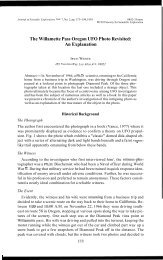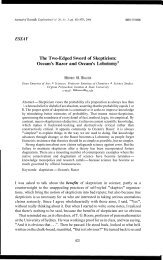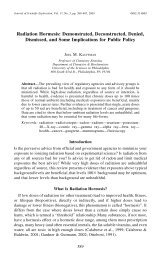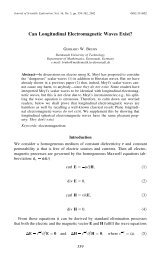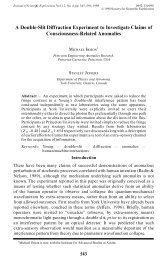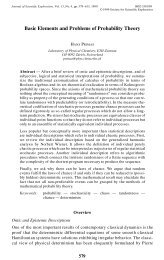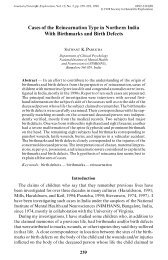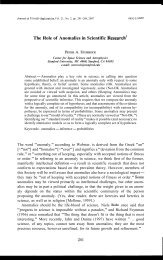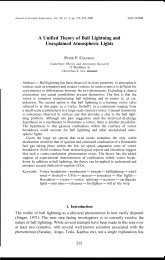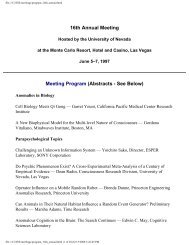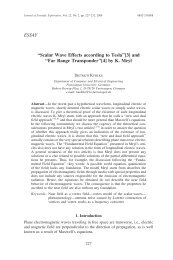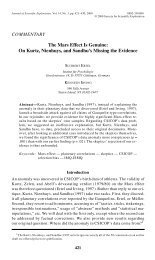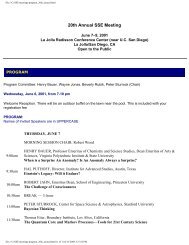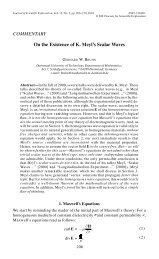Special New Energy Section: A Demon, a Law, and the Quest for ...
Special New Energy Section: A Demon, a Law, and the Quest for ...
Special New Energy Section: A Demon, a Law, and the Quest for ...
You also want an ePaper? Increase the reach of your titles
YUMPU automatically turns print PDFs into web optimized ePapers that Google loves.
EdgeScience<br />
Current Research <strong>and</strong> Insights<br />
<strong>Special</strong> <strong>New</strong> <strong>Energy</strong> <strong>Section</strong>:<br />
A <strong>Demon</strong>, a <strong>Law</strong>,<br />
<strong>and</strong> <strong>the</strong> <strong>Quest</strong><br />
<strong>for</strong> Virtually<br />
Free <strong>Energy</strong><br />
Cold Fusion:<br />
Is Vindication<br />
at H<strong>and</strong>?<br />
ALSO IN THIS ISSUE<br />
Breakthrough:<br />
Clues to Healing with Intention<br />
Extreme “Adventures”<br />
of Super Athletes<br />
A publication of <strong>the</strong> Society <strong>for</strong> Scientific Exploration<br />
Number 2 January–March 2010
EdgeScience #2<br />
January–March 2010<br />
EdgeScience is a quarterly magazine.<br />
Print copies are available from<br />
edgescience.magcloud.com.<br />
For fur<strong>the</strong>r in<strong>for</strong>mation, see<br />
edgescience.org<br />
Why EdgeScience? Because, contrary to public<br />
perception, scientific knowledge is still full of<br />
unknowns. What remains to be discovered — what<br />
we don’t know — very likely dwarfs what we do<br />
know. And what we think we know may not be<br />
entirely correct or fully understood. Anomalies,<br />
which researchers tend to sweep under <strong>the</strong> rug,<br />
should be actively pursued as clues to potential<br />
breakthroughs <strong>and</strong> new directions in science.<br />
PuBliShEr: The Society <strong>for</strong> Scientific Exploration<br />
EdiTor: Patrick huyghe<br />
ConTriBuTorS: William Bengston, dick<br />
Blasb<strong>and</strong>, Steve Braude, Michael Grosso,<br />
Benjamin Kessler, Garret Moddel, P. d.<br />
Moncrief, roger nelson, Michael Schmickler,<br />
Peter Sturrock<br />
dESiGn: Smythtype design<br />
AdvErTiSinG: dominique Surel<br />
The Society <strong>for</strong> Scientific Exploration (SSE) is a<br />
professional organization of scientists <strong>and</strong> scholars<br />
who study unusual <strong>and</strong> unexplained phenomena.<br />
The primary goal of <strong>the</strong> Society is to provide a<br />
professional <strong>for</strong>um <strong>for</strong> presentations, criticism,<br />
<strong>and</strong> debate concerning topics which are <strong>for</strong><br />
various reasons ignored or studied inadequately<br />
within mainstream science. A secondary goal is to<br />
promote improved underst<strong>and</strong>ing of those factors<br />
that unnecessarily limit <strong>the</strong> scope of scientific<br />
inquiry, such as sociological constraints, restrictive<br />
world views, hidden <strong>the</strong>oretical assumptions,<br />
<strong>and</strong> <strong>the</strong> temptation to convert prevailing <strong>the</strong>ory<br />
into prevailing dogma. Topics under investigation<br />
cover a wide spectrum. At one end are apparent<br />
anomalies in well established disciplines. At <strong>the</strong><br />
o<strong>the</strong>r, we find paradoxical phenomena that belong<br />
to no established discipline <strong>and</strong> <strong>the</strong>re<strong>for</strong>e may<br />
offer <strong>the</strong> greatest potential <strong>for</strong> scientific advance<br />
<strong>and</strong> <strong>the</strong> expansion of human knowledge. The<br />
SSE was founded in 1982 <strong>and</strong> has approximately<br />
800 members in 45 countries worldwide. The<br />
Society also publishes <strong>the</strong> peer-reviewed Journal<br />
of Scientific Exploration, <strong>and</strong> holds annual<br />
meetings in <strong>the</strong> u.S. <strong>and</strong> biennial meetings in<br />
Europe. Associate <strong>and</strong> student memberships<br />
are available to <strong>the</strong> public.To join <strong>the</strong> Society,<br />
or <strong>for</strong> more in<strong>for</strong>mation, visit <strong>the</strong> website at<br />
scientificexploration.org.<br />
PrESidEnT: Garret Moddel, university of Colorado<br />
viCE-PrESidEnT: Bob Jahn, Princeton university<br />
SECrETAry: Mark urban-lurain, Michigan State<br />
university<br />
TrEASurEr: John reed<br />
EuroPEAn CoordinATor: Erling Str<strong>and</strong>,<br />
Østfold College, norway<br />
Copyright © 2010 Society <strong>for</strong> Scientific Exploration<br />
CONTENTS<br />
3<br />
4<br />
5<br />
10<br />
14<br />
15<br />
20<br />
THE OBSERVATORY<br />
Types of Anomalies: OK, Not-Ok, <strong>and</strong> Sleeping<br />
An Editorial by Peter Sturrock<br />
LETTERS<br />
Some Fur<strong>the</strong>r Thoughts on Premonitions<br />
Feature<br />
Breakthrough: Clues to Healing with Intention<br />
By William Bengston<br />
SPeCIaL NeW eNerGY SeCtION<br />
Cover image © James Steidl<br />
A <strong>Demon</strong>, a <strong>Law</strong>, <strong>and</strong> <strong>the</strong> <strong>Quest</strong> <strong>for</strong><br />
Virtually Free <strong>Energy</strong><br />
By Garret Moddel<br />
NEWS NOTEBOOk<br />
Cold Fusion: Is Vindication at H<strong>and</strong>?<br />
REFERENCE POINT<br />
The Extreme “Adventures” of Super Athletes—<br />
<strong>and</strong> an Unwilling Neuroanatomist<br />
A review of Maria Coffey’s Explorers of <strong>the</strong> Infinite<br />
by Michael Schmicker <strong>and</strong> a review of Jill Bolte Taylor’s<br />
My Stroke of Insight by Michael Grosso<br />
BACk SCATTER<br />
<strong>Demon</strong>s On Mars
Anomalies should be <strong>the</strong> life-blood of science. Niels Bohr<br />
once said that “progress in science is impossible without<br />
a paradox,” <strong>and</strong> Richard Feynman has remarked that “The<br />
thing that doesn’t fit is <strong>the</strong> thing that is most interesting.”<br />
The crucial point to note about “anomaly” is that it is a<br />
relative concept, not an absolute concept. A result is an anomaly<br />
only with respect to a given <strong>the</strong>ory or hypo<strong>the</strong>sis. In scientific<br />
research, it would typically be an experimental or observational<br />
result that is not in accord with current <strong>the</strong>ory. Therein<br />
lies its importance: An anomaly provides a test of a <strong>the</strong>ory.<br />
As Feynman’s remark implies, it is<br />
much more important to search <strong>for</strong><br />
facts that do not agree with current<br />
<strong>the</strong>ory than to find fur<strong>the</strong>r facts that<br />
do agree with that <strong>the</strong>ory. If a certain<br />
fact, which is incompatible with a given<br />
<strong>the</strong>ory, can be firmly established, <strong>the</strong>n that<br />
<strong>the</strong>ory must be modified or ab<strong>and</strong>oned.<br />
Different anomalies evoke very different<br />
responses from <strong>the</strong> scientific<br />
community. To clarify<br />
matters, I suggest that<br />
we may distinguish three<br />
categories that we may refer<br />
to as “OK Anomalies,” “Not-OK Anomalies,” <strong>and</strong> “Sleeping<br />
Anomalies.”<br />
An “OK Anomaly” is one that has been discovered by<br />
an established scientist, preferably using expensive equipment,<br />
<strong>and</strong> which appears to be an anomaly that scientists can cope<br />
with. Examples of OK Anomalies include <strong>the</strong> discovery of<br />
quasars <strong>and</strong> pulsars. Claims <strong>for</strong> both of <strong>the</strong>se astronomical discoveries<br />
were made by established astronomers using powerful<br />
(<strong>and</strong> expensive) optical or radio telescopes. Both anomalies<br />
were viewed as due more to limitations in our astronomical<br />
knowledge than to errors in our underst<strong>and</strong>ing of physics.<br />
A “Not-OK Anomaly” is one that is not obviously resolvable<br />
<strong>and</strong> presents an unwelcome challenge to established<br />
scientists, possibly (but not necessarily) because it has been<br />
discovered by a non-scientist. A classical example of a Not-OK<br />
Anomaly is <strong>the</strong> case of meteorites. These objects fall from <strong>the</strong><br />
sky <strong>and</strong> may be discovered by any citizen (with or without a<br />
college degree), <strong>and</strong> no specialized equipment is required. In<br />
1772, French Academicians had ruled that <strong>the</strong>se objects could<br />
not have fallen from <strong>the</strong> sky, since <strong>the</strong>re are no stones in <strong>the</strong> sky<br />
to fall. The au<strong>the</strong>nticity of meteorite falls was finally <strong>and</strong> incontrovertibly<br />
established by <strong>the</strong> distinguished scientist Jean-<br />
Batiste Biot, who was sent by <strong>the</strong> President of <strong>the</strong> National<br />
Institute to investigate a particularly large meteorite fall (over<br />
3,000 stony meteorites) that occurred at L’Aigle, in Norm<strong>and</strong>y,<br />
on April 25, 1803. A list of current Not-OK anomalies would<br />
contain many topics that are generally dismissed as bogus by<br />
EDGE SCIENCE 3<br />
{THE OBSERVATORY|<br />
Peter Sturrock<br />
types of anomalies<br />
OK NOT-OK<br />
SLEEPING<br />
<strong>the</strong> scientific community, such as UFOs <strong>and</strong> psi phenomena,<br />
as well as cold fusion <strong>and</strong> anomalous healing, two subjects<br />
touched upon in this issue.<br />
A “Sleeping Anomaly” is one that has not yet been generally<br />
recognized as an anomaly. A historical example of a<br />
“Sleeping Anomaly” is <strong>the</strong> close geometrical match between<br />
<strong>the</strong> west coast of Africa <strong>and</strong> <strong>the</strong> east coast of South America.<br />
This fact had been noted by Francis Bacon <strong>and</strong> o<strong>the</strong>rs, but it<br />
was not generally recognized as a challenge to underst<strong>and</strong>ing<br />
until Alfred Wegener drew new attention to it early in <strong>the</strong><br />
20th Century. Wegener attributed <strong>the</strong> correspondence to <strong>the</strong><br />
breakup of one large continent (referred to as “Pangea”) <strong>and</strong><br />
<strong>the</strong> progressive separation of <strong>the</strong> parts by a process he called<br />
“continental drift.” This proposal was ridiculed <strong>for</strong> many<br />
years, especially by geophysicists.<br />
The tide turned when geophysicists<br />
found that <strong>the</strong> magnetic<br />
signatures on <strong>the</strong> two sides of<br />
<strong>the</strong> Mid-Atlantic Ridge were effectively<br />
mirror-imaged, showing<br />
this ridge to be a “spreading center,” a<br />
concept that plays a key role in what is<br />
known as “plate tectonics.”<br />
We now know that <strong>the</strong> scientific<br />
community was in error in its response to <strong>the</strong> challenge of<br />
meteorites <strong>and</strong> to that of continental configurations. Can we<br />
be sure that we, scientists of <strong>the</strong> 21st Century, are not making<br />
similar errors in our response to some current anomalies? A little<br />
doubt may be good medicine <strong>for</strong> one’s intellectual health.<br />
Peter Sturrock has spent most of his life as a conventional scientist,<br />
working on accelerator physics,<br />
elec tron physics, plasma physics,<br />
solar physics, astrophysics, <strong>and</strong><br />
statistics at Stan<strong>for</strong>d university.<br />
But he has in addition spent almost<br />
half his life studying topics that are<br />
decidedly unconventional. “it is<br />
ra<strong>the</strong>r like being a republican by<br />
day <strong>and</strong> a democrat by night,” notes<br />
Sturrock, “which would i suspect<br />
give one keener insight into both<br />
parties. By working in both conventional<br />
<strong>and</strong> unconventional areas,<br />
i have—i believe—developed a<br />
deeper appreciation of <strong>the</strong> strengths<br />
<strong>and</strong> weaknesses of both kinds of<br />
science.” his just published memoir A Tale of Two Sciences: Memoirs<br />
of a Dissident Scientist (www.exoscience.org) describes, among o<strong>the</strong>r<br />
things, <strong>the</strong> founding of <strong>the</strong> Society <strong>for</strong> Scientific Exploration.
4 EDGE SCIENCE<br />
Some Fur<strong>the</strong>r Thoughts<br />
on Premonitions<br />
I teach a class at Utah Valley University in a Technology<br />
Management Program entitled Reliability Engineering <strong>and</strong><br />
Safety. One of <strong>the</strong> chapters in this course is Situational Awareness.<br />
The definition of this concept is short <strong>and</strong> sweet; Knowing<br />
What is Going On Around You. In this class we discuss<br />
how to have Situational Awareness <strong>and</strong> how to recognize when<br />
you have lost it. There are 11 clues that can be observed in<br />
one’s operating vocations that tell you that you are losing your<br />
Situational Awareness.<br />
This research work was done in part at <strong>the</strong> University<br />
of Texas in <strong>the</strong>ir Psychology Department under grants from<br />
NASA some years ago. The principle researcher at that time<br />
was Robert Helmrich. The concept has been widely adopted<br />
in <strong>the</strong> commercial aviation industry <strong>and</strong> has become part of<br />
instructional ef<strong>for</strong>ts in many o<strong>the</strong>r safety critical industries.<br />
One of <strong>the</strong> results of <strong>the</strong>ir research was <strong>the</strong> observation<br />
that if 4 or 5 of <strong>the</strong>se clues are observed in a given activity,<br />
<strong>the</strong>re is a very high probability that a serious incident is imminent.<br />
The instruction is that <strong>the</strong> activity should be put in<br />
an idle or safe situation until <strong>the</strong> reason <strong>for</strong> <strong>the</strong> presence of <strong>the</strong><br />
clues can be ascertained <strong>and</strong> resolved. Ano<strong>the</strong>r observation of<br />
<strong>the</strong> research that became one of <strong>the</strong> clues was that if someone<br />
in <strong>the</strong> activity had a “Gut Feeling” that something was wrong,<br />
it should be carefully considered because <strong>the</strong> research showed<br />
that nearly 100% of <strong>the</strong> time, something bad happened.<br />
The 11 clues are;<br />
(1) Failure to meet Targets.<br />
(2) Use of an Undocumented Procedure<br />
(3) Departure from a St<strong>and</strong>ard Operating Procedure.<br />
(4) Violating Maximums or o<strong>the</strong>r Limitations.<br />
(5) “No One Flying <strong>the</strong> Plane” or No One in Control<br />
(6) No One Looking Out <strong>the</strong> Window or observing what<br />
is going on.<br />
(7) Communications Breakdowns<br />
(8) Presence of an Ambiguity or Anomalous data<br />
(9) Unresolved Discrepancies<br />
(10) Preoccupation or Distraction (fatigue or emotional<br />
situations<br />
(11) Confusion of Apprehensive Feeling or <strong>the</strong> Gut Feeling<br />
that something is wrong.<br />
Regarding clue 11, many dismiss various explanations as<br />
<strong>the</strong> subconscious observing a bad developing situation or seeing<br />
several of <strong>the</strong> clues by <strong>the</strong> subconscious. Personally, although<br />
some of <strong>the</strong>se o<strong>the</strong>r explanations may be valid, I am<br />
wondering if precognition may be operable in <strong>the</strong>se situations<br />
that are generally life threatening.<br />
An incident several years ago occurred with a Flying<br />
Tigers Airlines 747 on approach to Kuala Lumpur in Indonesia<br />
in <strong>the</strong> middle of a very dark night. From <strong>the</strong> direction <strong>the</strong>y<br />
were on approach, <strong>the</strong> Instrument L<strong>and</strong>ing System was out of<br />
service <strong>and</strong> <strong>the</strong>y would have had to go ano<strong>the</strong>r hundred miles<br />
to come in from <strong>the</strong> o<strong>the</strong>r direction where it was in service.<br />
While several of <strong>the</strong> clues to losing Awareness were eventually<br />
present (7, 8, 9 <strong>and</strong> 10), <strong>the</strong> first officer tried to get <strong>the</strong> captain<br />
to do <strong>the</strong> fly around, saying on three occasions, “Captain, I<br />
really don’t feel good about this, let’s go around <strong>and</strong> use <strong>the</strong><br />
instrument system.” These protestations occurred be<strong>for</strong>e any<br />
of <strong>the</strong> o<strong>the</strong>r clues were observable. Because of <strong>the</strong> ultimate<br />
presence of several of <strong>the</strong> clues, unrecognized, <strong>the</strong>y flew into a<br />
mountain. The o<strong>the</strong>r 4 clues were observable only just prior to<br />
<strong>the</strong> crash. From <strong>the</strong> data I observed in this incident, it appears<br />
<strong>the</strong> first officer’s comments were begun at least 15–20 minutes<br />
prior to <strong>the</strong> o<strong>the</strong>r four clues being observable.<br />
The info you supplied in your article (“Straight From <strong>the</strong><br />
Gut,” EdgeScience No.1) will be valuable in my class when we<br />
discuss Situational Awareness. I can’t put my finger on it precisely,<br />
but I have a feeling <strong>the</strong> ideas on precognition may be<br />
interacting somehow in <strong>the</strong> o<strong>the</strong>r 10 clues. Something to continue<br />
to ponder. Great article.<br />
—John MacLean<br />
First Issue<br />
Bravo—<strong>for</strong> a great job on <strong>the</strong> first issue of Edge Science . . .<br />
I especially enjoyed Roger Nelson’s sum mary of GCP/REG<br />
re search, <strong>and</strong> <strong>the</strong> inclusion of a review of one of my favorite<br />
books, Robert Becker’s The Body Electric, a review that not<br />
so incidentally also served as a tribute to <strong>the</strong> author, a true<br />
“EdgeScientist” if ever I’ve met one. —EWK<br />
Congratulations <strong>for</strong> such a nice, in<strong>for</strong>mative, <strong>and</strong> attractive<br />
first issue of EdgeScience. A publication like this was needed.<br />
—CSA<br />
I really enjoyed <strong>the</strong> first issue of EdgeScience magazine . . .<br />
—JR<br />
Love your new magazine . . .—JM<br />
Excellent first issue . . .—RW<br />
Absolutely fascinating . . .—CJ<br />
{LETTERS |
William F. Bengston<br />
EDGE SCIENCE 5<br />
Breakthrough:<br />
Clues to Healing with Intention<br />
very long time ago, soon after I graduated with a B.A.<br />
A in sociology from Niagara University, I met a man who<br />
claimed he had only recently discovered his own psychic abilities.<br />
At <strong>the</strong> time, in 1971, Bennett Mayrick was a house cleaner.<br />
He had held a variety of jobs be<strong>for</strong>e I met him, including<br />
floor installer, professional singer, etc. Basically, he was a jackof-all<br />
trades. Since I don’t naturally default to belief, I asked<br />
him if I could test his claim. He not only agreed but also actually<br />
welcomed <strong>the</strong> opportunity as he proclaimed himself a<br />
skeptic. And so a partnership was born.<br />
I began in <strong>the</strong> usual way, by giving him objects that belonged<br />
to various people <strong>and</strong> had him describe <strong>the</strong>ir character,<br />
surroundings, <strong>and</strong> events in <strong>the</strong>ir lives. I admit to having been<br />
impressed by his readings, even as I wondered if <strong>the</strong>re might<br />
be an element of self-delusion in all of it. And so I dragged<br />
him around to people who claimed to be experts in such matters.<br />
We went to <strong>the</strong> American Society <strong>for</strong> Psychical Research<br />
in Manhattan, to <strong>the</strong> dream lab at Maimonides Hospital in<br />
Brooklyn, <strong>and</strong> such. I found <strong>the</strong>se experiences to be quite frustrating,<br />
as <strong>the</strong> experts didn’t seem to have <strong>the</strong>ir methodological<br />
acts in order. And so I, a fledgling researcher in <strong>the</strong> early<br />
stages of graduate training, began to design double blind tests<br />
that were far more rigorous than anything <strong>the</strong> “experts” had<br />
prepared <strong>for</strong> us. In short, Bennett passed <strong>the</strong>se tests with flying<br />
colors, <strong>and</strong> I wondered what to do next.<br />
That problem didn’t last long, as one day while we sat in a<br />
kitchen talking about this <strong>and</strong> that, I had a flair up of chronic<br />
lower back pain that had made me give up a swimming scholarship.<br />
Off <strong>the</strong> cuff, I asked him to put his h<strong>and</strong>s on my back<br />
<strong>and</strong> take away <strong>the</strong> pain. He thought I was crazy but tried anyway.<br />
About ten minutes after he put his h<strong>and</strong>s on me, <strong>the</strong> pain<br />
went away. And decades later, it still hasn’t returned. If this<br />
was hysterical suppression of symptoms, I’ll take it!<br />
All of this was be<strong>for</strong>e <strong>the</strong> “new age” boom, when<br />
alternative-healing practices became widespread even if not accepted<br />
by <strong>the</strong> medical community. I watched Bennett put his<br />
h<strong>and</strong>s on person after person <strong>and</strong> saw much that I myself would<br />
never believe had I not witnessed it. Some ailments responded<br />
poorly or not at all. Warts, <strong>for</strong> instance. There was no effect at<br />
all on warts, <strong>and</strong> to this day I consider that to be a clue even<br />
as I continue to be flummoxed by what it means. On <strong>the</strong> o<strong>the</strong>r<br />
h<strong>and</strong>, cancer responded almost immediately, <strong>and</strong> <strong>the</strong> more aggressive<br />
<strong>the</strong> cancer <strong>the</strong> faster it seemed to respond. The only<br />
failures with cancer were with those who had had radiation<br />
or chemo<strong>the</strong>rapy. I suspect this is ano<strong>the</strong>r clue, which might<br />
mean that healing does not mix well with <strong>the</strong>rapies that kill.<br />
After watching many dozens of healings, I began to get<br />
frustrated. Sure, <strong>the</strong> cures were amazing, but <strong>the</strong> complexities<br />
involved in clinical cases made <strong>the</strong>m too fuzzy <strong>for</strong> my sensibilities.<br />
Did a cure result from <strong>the</strong> h<strong>and</strong>s-on treatment, <strong>the</strong><br />
extra vitamin C that <strong>the</strong> patient took, <strong>the</strong>ir personality type,<br />
or something else? I needed to know.<br />
And so with a friend named David Krinsley, we decided to<br />
take <strong>the</strong> healing phenomenon into <strong>the</strong> lab. At <strong>the</strong> time David<br />
was chair of <strong>the</strong> geology department at Queens College of <strong>the</strong><br />
City University of <strong>New</strong> York, <strong>and</strong> I was a fledgling instructor<br />
at St. Joseph’s College in <strong>New</strong> York, doing graduate work in<br />
sociology, specializing in criminology, <strong>the</strong> sociology of religion,<br />
<strong>and</strong> statistical modeling. David was in a position to call<br />
in some favors so he solicited <strong>the</strong> head of <strong>the</strong> biology department<br />
to devise a test that would be airtight. One of <strong>the</strong> chair’s<br />
department members had been doing mice studies on a particular<br />
<strong>for</strong>m of mammary adenocarcinoma that is 100 percent<br />
fatal within 27 days of injection. The model itself was so well<br />
understood that statistical studies of lifespan were routinely<br />
done, even as no mouse had ever lived past 27 days. If we<br />
could even get our mice to live closer to <strong>the</strong> 27 day mark, that<br />
would be strong evidence of a healing effect. If a mouse were<br />
to live to day 28, well, <strong>the</strong>n we’d own <strong>the</strong> world record.<br />
Our original intent was to have Bennett do <strong>the</strong> treatments,<br />
but circumstance had him back out at <strong>the</strong> last minute.<br />
We were <strong>the</strong>n left with cancer-infected mice <strong>and</strong> no healer.<br />
Ra<strong>the</strong>r than cancel <strong>the</strong> experiment, David convinced me to<br />
act as substitute healer. By that time I had spent a great deal<br />
of time watching, testing, <strong>and</strong> also assisting Bennett in some<br />
healing cases. And so, seeing no alternative, I reluctantly (<strong>and</strong><br />
without much confidence) agreed.<br />
A Skeptic as Healer<br />
I used healing techniques that Bennett <strong>and</strong> I developed<br />
through introspection, trial <strong>and</strong> error, <strong>and</strong> simple intuition.<br />
The techniques are completely belief-free <strong>and</strong> involve a process<br />
of extremely fast visualization of a series of personal images<br />
done in conjunction with <strong>the</strong> laying-on of h<strong>and</strong>s, in which <strong>the</strong><br />
person tries, with as little ef<strong>for</strong>t as possible, to feel an energy<br />
flowing out from <strong>the</strong> palms of his or her h<strong>and</strong>s. The images<br />
each person uses are generated by a personal list, prepared prior<br />
to <strong>the</strong> experiment, of 20 outcomes wanted in his or her life,<br />
specific goals that involve <strong>the</strong>ir own health, ideal jobs, material<br />
aspirations, or o<strong>the</strong>r people. Each item on <strong>the</strong> list is translated<br />
into an image that represents <strong>the</strong> achievement of that<br />
particular goal. These personal images are <strong>the</strong>n memorized<br />
<strong>and</strong> <strong>the</strong> prospective healer practices cycling through <strong>the</strong>m in<br />
a kind of mental filmstrip loop. This technique, ra<strong>the</strong>r than<br />
slowing down brain activity through some sort of meditative
6 EDGE SCIENCE<br />
technique, actually speeds up brain functioning <strong>and</strong> activity<br />
through <strong>the</strong> rapid visualization. At <strong>the</strong> same time <strong>the</strong> h<strong>and</strong>son<br />
technique is done in a very detached manner on <strong>the</strong> assumption<br />
that focus or belief would only get in <strong>the</strong> way. We<br />
can carry on normal conversations <strong>and</strong> even read while doing<br />
<strong>the</strong> h<strong>and</strong>s-on techniques.<br />
For an hour a day I placed my h<strong>and</strong>s around <strong>the</strong> cage of<br />
six mice, wondering how in <strong>the</strong> world I had come to this. Here<br />
I was, a skeptical researcher suddenly saddled with <strong>the</strong> task of<br />
treating a cancer that is always fatal.<br />
Since nei<strong>the</strong>r David nor I had any precedent in what we<br />
were doing, we naively suspected that if <strong>the</strong> treatment was to<br />
have any success <strong>the</strong>n ei<strong>the</strong>r <strong>the</strong> mice wouldn’t develop tumors<br />
or <strong>the</strong> tumors would be slow to grow. To our initial consternation,<br />
nei<strong>the</strong>r scenario occurred. Within a few days, palpable<br />
tumors developed on <strong>the</strong> mice, <strong>and</strong> I was discouraged to say<br />
<strong>the</strong> least. My initial reaction was to cancel <strong>the</strong> experiment,<br />
put <strong>the</strong> mice out of <strong>the</strong>ir suffering, <strong>and</strong> call it a day. David<br />
urged o<strong>the</strong>rwise, especially since he had gone to a great deal of<br />
trouble to set up <strong>the</strong> experiment. And so I continued <strong>the</strong> daily<br />
treatments even as <strong>the</strong> tumors grew larger.<br />
Any remaining hope I had disappeared as <strong>the</strong> tumors developed<br />
blackened areas on <strong>the</strong>m. I saw this as <strong>the</strong> beginning<br />
of <strong>the</strong> end. Then, <strong>the</strong> blackened areas ulcerated <strong>and</strong> <strong>the</strong> tumors<br />
split open. Again I urged that we do <strong>the</strong> ethical thing <strong>and</strong> end<br />
<strong>the</strong> experiment. But <strong>the</strong> biology chair noticed that <strong>the</strong> mice<br />
still had smooth coats <strong>and</strong> <strong>the</strong>ir eyes remained clear, <strong>and</strong> he<br />
wondered why <strong>the</strong>y were acting as though perfectly healthy.<br />
Then, in <strong>the</strong> final stages, <strong>the</strong> mice tumors simply imploded<br />
without any discharge or infection of any sort; it was a full<br />
lifespan cure. We were stunned. Here was a skeptical healer<br />
<strong>and</strong> a presumably non-believing group of mice that had gone<br />
through a novel pattern of remission to full cure in a mouse<br />
model without precedent of a cure.<br />
day 14: A mouse 14 days after being injected with mammary<br />
adenocarcinoma.<br />
Let’s Try That Again<br />
What to do next? Obviously replication. Even <strong>the</strong>n it occurred<br />
to me that if this healing phenomenon were to have any practical<br />
use, it needed to be independent of any individual. Plus,<br />
I was pretty burned out from <strong>the</strong> emotional rollercoaster of<br />
<strong>the</strong> experiment. And so I insisted that David, <strong>the</strong> biology<br />
chair, <strong>and</strong> two non-believing student volunteers submit to being<br />
trained in <strong>the</strong> healing techniques. The only requirement<br />
<strong>for</strong> inclusion in <strong>the</strong> experiment was that <strong>the</strong> volunteer healers<br />
not believe that healing was possible. I actually went through<br />
several students in my screening process to find <strong>the</strong> strongest<br />
levels of skepticism. Clearly I am not into faith healing.<br />
In fact, I’m quite sure that positive attitude isn’t necessary<br />
to do healing. Certainly belief isn’t ei<strong>the</strong>r. Speculatively, I<br />
think <strong>the</strong>re is a possibility that belief can hinder healing effects,<br />
as believers have a tendency to insert <strong>the</strong>mselves into <strong>the</strong> process<br />
because <strong>the</strong>y have a stake in <strong>the</strong> outcome (<strong>the</strong> same reason<br />
healers can’t generally heal <strong>the</strong>mselves). Healing is effective to<br />
<strong>the</strong> extent that <strong>the</strong> ego is removed. I also think that ritual (all<br />
ritual, really) destroys <strong>the</strong> thing that it is trying to reproduce.<br />
In healing, ritual blocks <strong>the</strong> “flow” of healing. People get very<br />
mad at me when I say this. And so in speculative hindsight, I<br />
unintentionally may have loaded <strong>the</strong> deck in my experiments<br />
by working only with non-believing clean slates.<br />
The four skeptical “volunteers” <strong>the</strong>n replicated what I<br />
did, <strong>and</strong> we got essentially <strong>the</strong> same results. All of <strong>the</strong> mice<br />
were cured. I <strong>the</strong>n moved <strong>the</strong> operation to St. Joseph’s College<br />
where I was working, <strong>and</strong> with <strong>the</strong> chair of <strong>the</strong> biology department<br />
<strong>the</strong>re did experiments three <strong>and</strong> four with o<strong>the</strong>r skeptical<br />
volunteers. In those experiments we also tried injecting <strong>the</strong><br />
mice with twice <strong>the</strong> dosage necessary to produce a fatal cancer,<br />
tried multiple injections, <strong>and</strong> even tried re-injecting <strong>the</strong>m after<br />
<strong>the</strong> experiment was over. But <strong>the</strong> mice remained immune to<br />
future injections throughout <strong>the</strong>ir two-year lifespan.<br />
day 22: A blackened area begins to develop on <strong>the</strong> tumor.
We have now done ten experiments on mice at five different<br />
institutions, including two medical schools. Eight of those<br />
experiments involved <strong>the</strong> same mammary adenocarcinoma,<br />
<strong>and</strong> two of <strong>the</strong>m used methylcholanthrene-induced sarcomas,<br />
which are not quite as aggressive. Though <strong>the</strong>se experiments<br />
achieved healing across <strong>the</strong> board, <strong>the</strong> intricacies of <strong>the</strong> results<br />
are complex <strong>and</strong>, frankly, quite puzzling.<br />
Control Group Cures<br />
Among <strong>the</strong> more interesting complications is that under certain<br />
conditions, our untreated control group mice also remitted.<br />
If <strong>the</strong> control mice were housed in a different building<br />
than <strong>the</strong> experimental mice, <strong>the</strong>y always died on schedule.<br />
But if anyone who knew <strong>the</strong> healing techniques came into a<br />
room where <strong>the</strong> control mice were housed, <strong>the</strong> infected mice<br />
who were still living went through <strong>the</strong> process of remission of<br />
blackened area to ulceration to tumor implosion to full lifespan<br />
cure. At first this was extremely annoying, as conventional<br />
scientific analysis takes success to mean that <strong>the</strong>re was a greater<br />
effect in treated verses untreated groups. But if <strong>the</strong> untreated<br />
control mice also got cured, <strong>the</strong>n <strong>the</strong>re were no differences <strong>for</strong><br />
us to report! At first we simply relied on <strong>the</strong> fact that <strong>the</strong> mice<br />
we were working with always died when injected with cancers,<br />
<strong>and</strong> so we already knew what should have happened with our<br />
mice. All of <strong>the</strong>m should have died. But since mice from both<br />
groups were getting cured, we knew we had ano<strong>the</strong>r clue. It<br />
was just a very difficult clue to interpret.<br />
I worked on this problem <strong>for</strong> a long time until I realized<br />
that perhaps one of <strong>the</strong> basic assumptions of experimental<br />
methods might just be incomplete: that separate groups<br />
are independent. If that assumption of independence between<br />
groups can be violated, <strong>the</strong>n perhaps I could account <strong>for</strong> <strong>the</strong><br />
remitting control mice. Perhaps all <strong>the</strong> mice were somehow<br />
day 28: Tumor ulceration begins. day 35: Tumor ulceration.<br />
EDGE SCIENCE 7<br />
resonantly bonded with each o<strong>the</strong>r. Our colleagues in physics<br />
are certainly used to entanglement, or what Einstein famously<br />
called “spooky action at a distance,” but only on a microscopic<br />
level. As far as I know, entanglement has only been shown<br />
to about 100 or so atoms, certainly fewer than <strong>the</strong> number<br />
of atoms in a mouse. Yet we were getting similar effects in<br />
complete biological organisms. I wonder how many o<strong>the</strong>r labs<br />
might have experienced resonant bonding between <strong>the</strong>ir experimental<br />
<strong>and</strong> control groups, <strong>and</strong> mistakenly concluded that<br />
<strong>the</strong>ir experiments were not successful <strong>and</strong> dismissed <strong>the</strong>ir findings?<br />
(This is called a “type II” error – thinking that nothing<br />
significant happened when in fact it did.)<br />
Placebo Effects<br />
A few years back I was giving a talk on this possibility at <strong>the</strong><br />
2003 Paris meeting of <strong>the</strong> Society <strong>for</strong> Scientific Exploration<br />
when a group from a lab in Freiburg, Germany, jumped up<br />
excitedly <strong>and</strong> said that I may have solved <strong>the</strong> placebo problem.<br />
I expressed gratitude to <strong>the</strong>m <strong>for</strong> saying that, but I also said<br />
that I didn’t know what <strong>the</strong> problem was. Like many people, I<br />
assumed that <strong>the</strong> placebo phenomenon was simply <strong>the</strong> power<br />
of suggestion, <strong>and</strong> that doctors, <strong>for</strong> example, might prescribe<br />
an inert pill that could produce real effects in a patient because<br />
of that suggestion.<br />
But after <strong>the</strong> conference, I began to look into placebos<br />
a bit more, <strong>and</strong> what I found astonished me. The idea that a<br />
placebo could produce real physiological effects was unthinkable<br />
in medicine 50 years ago, but by now medicine recognizes<br />
that placebos do work, even as <strong>the</strong> mechanism by which <strong>the</strong>y<br />
work <strong>and</strong> <strong>the</strong> circumstances under which <strong>the</strong>y work remain a<br />
mystery. Yet, in fact, it turns out that placebo effects increase<br />
over time to <strong>the</strong> point where up to 80 percent of <strong>the</strong> effects<br />
of drugs can be mirrored in placebos. The strength of this
8 EDGE SCIENCE<br />
effect has made it difficult <strong>for</strong> drug companies to prove that<br />
<strong>the</strong>ir new drugs work, as <strong>the</strong> gold st<strong>and</strong>ard of double-blind,<br />
placebo-controlled trials often end up mimicking <strong>the</strong> effects of<br />
<strong>the</strong> real drug in <strong>the</strong> control groups that only get placebo.<br />
I began to speculate that perhaps this was happening to<br />
my mice. While <strong>the</strong>y were not technically getting a placebo,<br />
<strong>the</strong> fact that <strong>the</strong> untreated mice kept getting cured was obviously<br />
suggestive. Perhaps <strong>the</strong> same process was at work. Perhaps<br />
experimental <strong>and</strong> control groups aren’t as independent<br />
as we once thought, <strong>and</strong> just as people taking an inert pill<br />
respond as if getting an active substance, my control group<br />
mice were responding as if getting an actual healing. Could it<br />
all be connected? If so, we have to do some serious re-thinking<br />
of <strong>the</strong> assumptions of classical experimental design. Perhaps<br />
a treatment given to one group is also a treatment given to<br />
all groups? I’ve designed a sequential series of experiments to<br />
tease out what percentage of <strong>the</strong> placebo effect is due to suggestion<br />
<strong>and</strong> what percentage is due to resonant bonding, but<br />
I’ve yet to get funding or a lab to carry out <strong>the</strong> work.<br />
The placebo/resonant bonding problem has also given<br />
me pause about whe<strong>the</strong>r healing can indeed be taught. I once<br />
thought that since I taught non-believers my healing techniques<br />
<strong>and</strong> <strong>the</strong>y <strong>the</strong>n went on to cure mice that o<strong>the</strong>rwise<br />
would have surely died that I had demonstrated that my techniques<br />
were learned <strong>and</strong> effective. Now I’m not so sure. Think<br />
about it: if we have an experiment where five volunteers are<br />
trying to remit <strong>the</strong>ir cage of mice, even if only one person is<br />
able to do it <strong>the</strong>n perhaps all <strong>the</strong> mice will be cured anyway<br />
<strong>and</strong> each volunteer will assume that he or she is <strong>the</strong> one who<br />
produced <strong>the</strong> cure. This is a daunting problem. In one experiment<br />
I was treating numerous cages of mice <strong>for</strong> different<br />
lengths of time trying to figure out what is <strong>the</strong> minimum dose<br />
necessary to produce a healing, <strong>and</strong> in one of <strong>the</strong> cages I never<br />
saw <strong>the</strong> mice but only held water that was fed to <strong>the</strong>m. At <strong>the</strong><br />
end of <strong>the</strong> experiment all of <strong>the</strong> mice were cured. Should I<br />
conclude that treated water can cure cancerous mice, or was<br />
it perhaps due to resonant bonding of all of <strong>the</strong> mice so that a<br />
treatment given to one is a treatment given to all? I’m still not<br />
sure of <strong>the</strong> answer.<br />
Where Should We Go From Here?<br />
All of this work is in <strong>the</strong> early <strong>and</strong> preliminary stages, but at<br />
this point <strong>the</strong>re are some conclusions that can be made with<br />
relative certainty, <strong>and</strong> some conclusions that are a bit more<br />
tricky. The largest category, of course, is <strong>the</strong> enormous list<br />
of things we don’t know. There is certainly plenty of research<br />
that needs to be done.<br />
The most unambiguous conclusion is that cancer can be<br />
cured in experimental animals. Even a doubter such as myself<br />
has to throw in <strong>the</strong> skeptical towel after ten experiments. At<br />
this point we have only tested two types of cancers, <strong>and</strong> it remains<br />
to be seen whe<strong>the</strong>r different cancers respond differently<br />
to healing techniques.<br />
All of <strong>the</strong> cured mice lived <strong>the</strong>ir normal lifespan of two<br />
years. After <strong>the</strong> initial cure, subsequent re-injections simply<br />
had no effect on <strong>the</strong> mice. This strongly suggests that an<br />
immune response is somehow being stimulated in <strong>the</strong> animals.<br />
If that is <strong>the</strong> case, perhaps <strong>the</strong> stimulated immune response can<br />
somehow be transferred to an animal that has not received <strong>the</strong><br />
healing treatments. In fact, after one experiment was over <strong>and</strong><br />
I was no longer involved in <strong>the</strong> day-to-day business of <strong>the</strong> animal<br />
labs, some cells were taken without my knowledge from<br />
remitting mice <strong>and</strong> transplanted to fully infected mice just to<br />
see what would happen; <strong>the</strong> transplanted cells seem to have in<br />
turn cured <strong>the</strong> fully infected mice. This suggests we might<br />
have <strong>the</strong> potential <strong>for</strong> ei<strong>the</strong>r a literal or metaphorical vaccine<br />
that could reproduce <strong>the</strong> healing without <strong>the</strong> healer. Is <strong>the</strong>re<br />
an immunologist who would be willing to take on this work?<br />
What are <strong>the</strong> correlates of healing, in <strong>the</strong> healer, <strong>the</strong> healee,<br />
<strong>and</strong> <strong>the</strong> surrounding environment? We have undertaken o<strong>the</strong>r<br />
experiments to find answers to such questions.<br />
Margaret Moga <strong>and</strong> I have done three mice experiments<br />
on mammary cancer at her lab at Indiana University Medical<br />
School, <strong>and</strong> while going through <strong>the</strong> usual routine of h<strong>and</strong>son<br />
healing, also strategically placed geomagnetic probes to<br />
test whe<strong>the</strong>r <strong>the</strong>re might be some interesting environmental<br />
correlates to <strong>the</strong> healing. And so we examined DC magnetic<br />
field activity during h<strong>and</strong>s-on healing <strong>and</strong> distant healing of<br />
mice with experimentally induced tumors. And, in fact, during<br />
<strong>the</strong> healing sessions we observed distinct magnetic field<br />
oscillations adjacent to <strong>the</strong> mice cages beginning as 20-30 Hz<br />
oscillations, slowing to 8-9 Hz, <strong>and</strong> <strong>the</strong>n to less than 1 Hz,<br />
at which point <strong>the</strong> oscillations reversed <strong>and</strong> increased in frequency,<br />
with an overall symmetrical appearance resembling a<br />
“chirp” wave. The waves ranged from 1-8 milligauss peak-topeak<br />
in strength <strong>and</strong> 60-120 seconds in duration. We speculate<br />
that this evidence may suggest that bioenergy healing may<br />
be detectable with DC gauss meters.<br />
About three years ago, independent researcher Luke Hendricks<br />
contacted me about my research with <strong>the</strong> mice. Luke is<br />
interested in both brain research <strong>and</strong> <strong>the</strong> practical applications<br />
of healing. After a few conversations about research possibilities,<br />
he in turn approached Jay Gunkelman of Q-Pro Worldwide,<br />
a leading authority on EEGs, about carrying out some<br />
experiments on brain correlates of my healing techniques. And<br />
so we all met at one of Jay’s labs in Phoenix to look at interpersonal<br />
coupling or connectivity between healer <strong>and</strong> healee pairs<br />
using advanced signal processing approaches <strong>and</strong> instantaneous<br />
EEG phase coupling. Our results showed harmonic frequency<br />
coupling across <strong>the</strong> spectra, followed by EEG entrainment<br />
effects between individuals, <strong>and</strong> <strong>the</strong>n by instantaneous<br />
EEG phase locking. These results suggest <strong>the</strong> presence of a<br />
connection between <strong>the</strong> healer <strong>and</strong> healee through a pattern<br />
of harmonics consistent with Schumann Resonances. If <strong>the</strong>se<br />
data hold in subsequent tests, we may have isolated at least one<br />
connectivity mechanisms underlying healing.<br />
But <strong>the</strong> questions go on <strong>and</strong> on. What happens when healing<br />
occurs? Do different healing techniques produce different<br />
results? Can healing be “stored”? Are placebo effects instances<br />
of resonant bonding? At this point, frankly, we’re not sure yet<br />
of <strong>the</strong> proper questions to ask.<br />
And mainstream science <strong>and</strong> medicine has not exactly<br />
been supportive. My history of research has generally followed
a two-step process. Each new lab expresses disbelief at my data<br />
obtained at o<strong>the</strong>r labs, <strong>and</strong> <strong>the</strong> researchers <strong>the</strong>re take on a<br />
“oh yeah, well you couldn’t get those results here” approach.<br />
When <strong>the</strong> mice get cured in <strong>the</strong> first experiment at any lab, it<br />
is usually taken as a gauntlet by lab personnel that <strong>the</strong>y can<br />
thwart future positive results. Then, when <strong>the</strong> second experiment<br />
also produces full lifespan cures, it is often followed by<br />
head shaking <strong>and</strong> proclamations to <strong>the</strong> effect that this is <strong>the</strong><br />
most amazing thing <strong>the</strong>y have ever seen. But when I suggest<br />
fur<strong>the</strong>r research, <strong>the</strong>re is always some reason that <strong>the</strong> work<br />
cannot continue at that institution. When I suggest that it is<br />
my goal to reproduce <strong>the</strong> remissions without <strong>the</strong> healing techniques<br />
by using ei<strong>the</strong>r <strong>the</strong> blood of cured animals or some<br />
correlate to <strong>the</strong> healing, my suggestion is usually met with<br />
intense skepticism that such a thing might be possible. I will,<br />
none<strong>the</strong>less, persevere.<br />
Healing Humans<br />
The eight hundred pound gorilla in <strong>the</strong> middle of <strong>the</strong> room<br />
is <strong>the</strong> question of whe<strong>the</strong>r any of this works on people. It is<br />
unambiguously <strong>the</strong> case that increasing numbers of people<br />
around <strong>the</strong> country are seeking out alternative <strong>and</strong> complementary<br />
medicine, which at this point in time must be classified<br />
as a growth industry. There are any number of schools<br />
of healing, workshops on healing, <strong>and</strong> practitioners of <strong>the</strong><br />
various alternative-healing arts. But do <strong>the</strong>y work? Surely <strong>the</strong><br />
practitioners will swear by whatever it is that <strong>the</strong>y do. But my<br />
non-systematic experience is that very few practices are rooted<br />
in rigorous data. That is not to say that <strong>the</strong>y don’t work; it is<br />
only to say that <strong>the</strong>re are too many anecdotes out <strong>the</strong>re not<br />
matched with empirical testing.<br />
As I noted at <strong>the</strong> beginning, my experimental work grew<br />
out of clinical observations <strong>and</strong> my frustrations at not being<br />
able to isolate what works <strong>and</strong> why through clinical observation.<br />
Certainly people have been taught my techniques <strong>and</strong> applied<br />
<strong>the</strong>m to people with some interesting anecdotal results.<br />
But to a researcher anecdotes are simply not enough.<br />
At what point will <strong>the</strong>re be enough evidence to do a controlled<br />
study on people? I don’t think <strong>the</strong> question has a clear<br />
answer. While my passion is in <strong>the</strong> lab, I would certainly be<br />
open to some clinical trials. But in my experience watching<br />
human cancers being treated decades ago, my anecdotal clinical<br />
observation was that <strong>the</strong> most successful remissions were<br />
all associated with a lack of conventional treatments whose<br />
purpose was to kill cancer cells. When people speak of “complementary<br />
medicine,” perhaps <strong>the</strong> methods I am aware of are<br />
not really complementary to <strong>the</strong> current crop of conventional<br />
treatments. If that turns out to be so, <strong>the</strong>n <strong>the</strong> difficulties of<br />
carrying out successful clinical trials are greatly compounded.<br />
I don’t yet know how to solve this problem. I do know that it<br />
is a problem worth pursuing.<br />
EDGE SCIENCE 9<br />
For Fur<strong>the</strong>r Reading:<br />
Luke Hendricks, William F. Bengston, Jay Gunkelman, “The<br />
Healing Connection: EEG Harmonics, Entrainment, <strong>and</strong><br />
Schumann’s Resonances,” Journal of Scientific Exploration,<br />
submitted.<br />
Margaret M. Moga, William F. Bengston, “Anomalous DC<br />
Magnetic Field Activity during a Bioenergy Healing Experiment,”<br />
Journal of Scientific Exploration, submitted.<br />
William F. Bengston, Donald G. Murphy, “Can Healing Be<br />
Taught?” Explore, vol 4(3), pp. 197–200, May/June 2008.<br />
William F. Bengston, Margaret M. Moga, “Resonance, Placebo<br />
Effects, <strong>and</strong> Type II Errors: Some Implications from Healing<br />
research <strong>for</strong> Experimental Methods,” Journal of Alternative<br />
<strong>and</strong> Complementary Medicine, vol. 13(3), pp. 317–327,<br />
May 2007.<br />
William F. Bengston, “A Method Used to Train Skeptical Volunteers<br />
to Heal in an Experimental Setting,” Journal of Alternative<br />
<strong>and</strong> Complementary Medicine, vol 13(3), May 2007.<br />
William F. Bengston, “Methodological Difficulties Involving<br />
Control Groups in Healing Research,” The Journal of Alternative<br />
<strong>and</strong> Complementary Medicine, vol. 10(2), April 2004.<br />
William F. Bengston, “Some Implications of <strong>the</strong> Bengston/<br />
Krinsley Healing Experiments,” Monterey Institute <strong>for</strong> <strong>the</strong><br />
Study of Alternative Healing Arts, vol. 30-31, December 2000,<br />
pp. 12–15.<br />
William F. Bengston, David Krinsley, “The Effect of <strong>the</strong><br />
Laying-On of H<strong>and</strong>s on Transplanted Breast Cancer in<br />
Mice,” Journal of Scientific Exploration, vol. 14(3), Fall 2000,<br />
pp. 353–364.<br />
William F. Bengston is a professor<br />
of sociology at St. Joseph’s<br />
College in new york. he received<br />
his Ph.d. from Fordham university<br />
in 1980. Bill has been a<br />
member of <strong>the</strong> Society <strong>for</strong> Scientific<br />
Exploration since 1999 <strong>and</strong><br />
currently serves on its executive<br />
council. he has written a memoir<br />
(with Sylvia Fraser) about his<br />
healing research entitled Chasing<br />
<strong>the</strong> Cure, which will be published<br />
in Canada by Key Porter in<br />
March 2010, <strong>and</strong> in <strong>the</strong> u.S. by<br />
Sounds True publishers in September<br />
2010 under <strong>the</strong> title The<br />
<strong>Energy</strong> Cure. he can be reached<br />
at wbengston@sjcny.edu.
10 EDGE SCIENCE<br />
Garret Moddel Illustrations by Benjamin Kessler<br />
a <strong>Demon</strong>, a <strong>Law</strong>, <strong>and</strong> <strong>the</strong> <strong>Quest</strong> <strong>for</strong><br />
Virtually Free energy<br />
If you believe what you read on <strong>the</strong> internet, new sources<br />
of energy now exist that can provide limitless, nonpolluting,<br />
virtually free power. Supposedly <strong>the</strong>se<br />
new sources have been patented <strong>and</strong> proven by<br />
scientists, but <strong>the</strong>y aren’t generally available because<br />
power companies or government agencies are<br />
suppressing in<strong>for</strong>mation about <strong>the</strong>m. The most tantalizing<br />
of <strong>the</strong>se purported energy sources is <strong>the</strong> vacuum, specifically<br />
zero-point energy in <strong>the</strong> <strong>for</strong>m of ubiquitous electromagnetic<br />
waves. The great thing about zero point energy is that, unlike<br />
many o<strong>the</strong>r sources of energy, it doesn’t have to be extracted<br />
from <strong>the</strong> ground because it’s literally everywhere around us.<br />
What is zero-point energy? ZPE, <strong>for</strong> short, can be viewed<br />
as a consequence of <strong>the</strong> uncertainty principle in quantum<br />
mechanics. According to this principle, we cannot know both<br />
<strong>the</strong> position <strong>and</strong> speed (or more precisely, <strong>the</strong> momentum) of<br />
a particle to absolute precision. If a particle were at rest, we<br />
would know both. There<strong>for</strong>e no particle is ever completely<br />
at rest, even at absolute zero temperature. Hence zero-point<br />
energy. Not only does ZPE make all matter vibrate, but even<br />
empty space can’t escape its effects. All space is filled with<br />
this quantum vacuum energy, resulting in a huge quantity of<br />
electromagnetic waves that tantalize us, saying “Take me . . . if<br />
you can.”<br />
The question is: Can we? Can we extract this energy from<br />
<strong>the</strong> vacuum?<br />
The <strong>Demon</strong> is in <strong>the</strong> Details<br />
Let’s step back from <strong>the</strong> hype <strong>and</strong> take a look at <strong>the</strong> fundamental<br />
underpinnings of vacuum energy extraction to see whe<strong>the</strong>r<br />
it makes sense. To do so, we must first underst<strong>and</strong> <strong>the</strong> second<br />
law of <strong>the</strong>rmodynamics. One of<br />
<strong>the</strong> ways to state this law, as introduced<br />
by Rudolf Clausius in 1865,<br />
is that heat can’t flow spontaneously from a<br />
cool region to a warm region. To underst<strong>and</strong><br />
this on a microscopic level, picture two<br />
chambers filled with gas, one hot <strong>and</strong> <strong>the</strong><br />
o<strong>the</strong>r cold, connected by a small hole. Energetic,<br />
hot air molecules diffuse from <strong>the</strong> hot chamber<br />
to <strong>the</strong> cold, <strong>and</strong> lethargic, cold molecules flow in <strong>the</strong><br />
opposite direction. The effect is that heat flows from<br />
a hot region to a cold one, <strong>and</strong> not <strong>the</strong> o<strong>the</strong>r way around. Is<br />
<strong>the</strong>re a way to reverse this process?<br />
Let’s imagine, as Scottish physicist James Clerk Maxwell<br />
did in 1867, that <strong>the</strong>re’s a little fellow who can. His name<br />
is Maxwell’s demon <strong>and</strong> his sole mission in life is to violate<br />
<strong>the</strong> second law of <strong>the</strong>rmodynamics. The demon guards a door<br />
blocking <strong>the</strong> hole between <strong>the</strong> chambers. Every time he sees<br />
an energetic molecule coming towards <strong>the</strong> hole from <strong>the</strong> hot<br />
chamber he closes <strong>the</strong> door. He does <strong>the</strong> same thing when he<br />
sees a lethargic air molecule approaching from <strong>the</strong> cold side.<br />
His devious nature emerges when he sees <strong>the</strong> occasional energetic<br />
molecule approaching from <strong>the</strong> cold side or <strong>the</strong> occasional<br />
lethargic molecule coming from <strong>the</strong> hot side. Out of<br />
spite <strong>for</strong> Clausius he lets <strong>the</strong>m through. In this way <strong>the</strong> hot<br />
region becomes hotter by taking energy from <strong>the</strong> cold region,<br />
which becomes colder. The demon is <strong>the</strong> embodiment of a<br />
one-way valve <strong>for</strong> heat flow.<br />
Can a real process exist that is represented by this demon’s<br />
actions? After more than a century of creative proposals <strong>for</strong><br />
Maxwell’s demons, none has been found to exist. There really<br />
is no way to make heat flow spontaneously from a cold region<br />
to a hot one, or to provide useful energy by <strong>for</strong>ming hot spots<br />
of ga<strong>the</strong>red heat from a uni<strong>for</strong>m temperature background.<br />
You can’t get around <strong>the</strong> second law, so this little demon just<br />
can’t exist.<br />
But even proposals that claim not to be based on Maxwell’s<br />
demon to extract energy from <strong>the</strong> vacuum actually do<br />
depend on <strong>the</strong> little devil—<strong>and</strong> <strong>the</strong>re<strong>for</strong>e fail.<br />
No Way <strong>for</strong> One-Way Valves<br />
In a talk presented at <strong>the</strong> 2009 “Workshop on Future <strong>Energy</strong><br />
Sources” with proceedings published by <strong>the</strong> American<br />
Institute of Physics, an investigator proposed using a diode,<br />
a one-way valve <strong>for</strong> electrical current, to harvest ZPE because<br />
<strong>the</strong>se electromagnetic waves not only fill all of space, <strong>the</strong>y<br />
also produce electrical oscillations in electronic components.<br />
The idea is that <strong>the</strong> uni<strong>for</strong>m background ZPE would cause
oscillations—electrical charge moving back <strong>and</strong> <strong>for</strong>th—in a<br />
diode. And since a diode allows flow preferentially in one direction,<br />
electrical charge would build up on one side. This<br />
build-up could <strong>the</strong>n be used to charge a battery.<br />
Can this really be done? Or does this require Maxwell’s<br />
demon <strong>and</strong> is <strong>the</strong>re<strong>for</strong>e really impossible? After all, a diode is<br />
just a one-way valve, <strong>the</strong> demon’s area of expertise. ZPE exists<br />
in a state of true equilibrium, which means that its energy is<br />
as evenly distributed as if it were at a uni<strong>for</strong>m temperature.<br />
But Clausius already told us that <strong>the</strong>re is no way to harvest any<br />
energy from a uni<strong>for</strong>m distribution. So this concept<br />
cannot work.<br />
How can we be so sure that one-way valves<br />
cannot harvest energy from equilibrium? Maybe<br />
Clausius got it wrong <strong>and</strong> someone will come<br />
along someday to correct his version of <strong>the</strong><br />
second law, just as Einstein came along <strong>and</strong><br />
corrected <strong>New</strong>ton’s law of gravitation. Un<strong>for</strong>tunately,<br />
<strong>the</strong>se are two very different types<br />
of situations. <strong>New</strong>ton’s law was based on observation<br />
<strong>and</strong> abstraction. If <strong>New</strong>ton had been<br />
observing <strong>the</strong> effects of gravitational <strong>for</strong>ces with<br />
sufficient precision <strong>and</strong> at cosmic scales, he might have<br />
come up with Einstein’s more accurate picture instead. The<br />
second law of <strong>the</strong>rmodynamics is different. Although it may<br />
have originated from observations, it has been re-developed<br />
using statistical mechanics, an application of probability <strong>and</strong><br />
pure logic, <strong>and</strong> it is now supported by a foundation stronger<br />
<strong>and</strong> more accurate than any observation. Einstein wrote<br />
that classical <strong>the</strong>rmodynamics “is <strong>the</strong> only physical <strong>the</strong>ory of<br />
universal content which I am convinced will never be overthrown<br />
. . . ”<br />
What Goes Down Must Come Up<br />
One of <strong>the</strong> problems with extracting zero-point energy from<br />
<strong>the</strong> vacuum is that <strong>the</strong> vast majority of this energy is in <strong>the</strong> <strong>for</strong>m<br />
of extremely high-frequency electromagnetic waves. There<br />
is not much energy at radio <strong>and</strong> television-wave frequencies<br />
(around 100 million cycles per second) or even at microwave<br />
frequencies (around 10 billion cycles per second). Only when<br />
you get up to <strong>the</strong> frequencies of visible light (around 1 million<br />
billion cycles per second) is <strong>the</strong>re enough energy to be useful<br />
as a power source. The problem is that today’s electronics can’t<br />
work at those high frequencies. For that reason, two U.S. Air<br />
Force researchers proposed a system intended to down-convert<br />
<strong>the</strong> high-frequency ZPE waves to lower frequencies, where<br />
<strong>the</strong>y could be harvested <strong>for</strong> use in electronics. The researchers<br />
received a patent <strong>for</strong> this in 1996 (U.S. # 5,590,031).<br />
Frequency down-conversion, like <strong>the</strong> use of diodes to<br />
convert electrical oscillations into direct current, makes use<br />
of what is called a nonlinear substance or device. Many minerals<br />
<strong>and</strong> all living material are nonlinear to some extent. If a<br />
nonlinear substance were sufficient to down-convert electromagnetic<br />
waves of ZPE <strong>the</strong>n we would see hot spots wherever<br />
<strong>the</strong>re was such a material. This is because <strong>the</strong> low-frequency<br />
oscillations that resulted from <strong>the</strong> down-converting of <strong>the</strong>se<br />
EDGE SCIENCE 11<br />
fields would end up as heat. Maxwell’s<br />
demon would have a heyday<br />
producing <strong>the</strong>se hot spots<br />
from <strong>the</strong> background energy.<br />
But we don’t see such hot spots,<br />
once again because <strong>the</strong> energy in<br />
<strong>the</strong> vacuum is uni<strong>for</strong>mly distributed;<br />
it’s in equilibrium. Based on<br />
this, Einstein developed a detailed<br />
balance description of emission <strong>and</strong><br />
absorption in 1916. According to<br />
this balance, <strong>the</strong>re is in fact downconversion<br />
of vacuum energy into heat,<br />
but <strong>the</strong>re is an exactly equal amount of<br />
up-conversion of <strong>the</strong> heat into vacuum<br />
energy. So <strong>the</strong>re is no net flow of energy<br />
from <strong>the</strong> vacuum. The proposed downconversion<br />
can’t work, un<strong>for</strong>tunately.<br />
One-Trick Casimir Cavities<br />
Ano<strong>the</strong>r attractive approach to harvesting<br />
vacuum energy involves Casimir cavities. In 1947, <strong>the</strong><br />
Dutch physicist Hendrik Casimir was developing a <strong>the</strong>ory that<br />
predicted <strong>the</strong> existence of previously unknown <strong>for</strong>ces between<br />
two closely spaced objects. He described his findings to Niels<br />
Bohr, <strong>the</strong> gr<strong>and</strong>fa<strong>the</strong>r of quantum mechanics, as <strong>the</strong>y took<br />
a walk toge<strong>the</strong>r. In response to Casimir’s description, Bohr<br />
mumbled something about zero-point energy. Casimir had<br />
<strong>the</strong> answer he needed.<br />
The two plates on ei<strong>the</strong>r side of a Casimir cavity are like<br />
two ships at sea. Waves pushing against <strong>the</strong> starboard sides of<br />
each ship are balanced by waves pushing against <strong>the</strong> port sides.<br />
But when <strong>the</strong> two ships move too closely alongside each o<strong>the</strong>r,<br />
<strong>the</strong>y block <strong>the</strong> waves between <strong>the</strong>m. Waves on <strong>the</strong> open-sea<br />
sides of <strong>the</strong> ships are no longer balanced by waves on <strong>the</strong> o<strong>the</strong>r<br />
sides, with <strong>the</strong> result that <strong>the</strong> ships are pushed toge<strong>the</strong>r. Similarly,<br />
ZPE electromagnetic waves push against <strong>the</strong> Casimir<br />
plates. When <strong>the</strong> plates are spaced closely enough <strong>the</strong>y block<br />
some of <strong>the</strong> long wavelength waves from <strong>for</strong>ming between<br />
<strong>the</strong>m, with <strong>the</strong> result that <strong>the</strong> plates are pushed toge<strong>the</strong>r. This<br />
effect becomes noticeable only <strong>for</strong> spacings that are less than<br />
one millionth of a meter.
12 EDGE SCIENCE<br />
In 1999 <strong>and</strong> <strong>the</strong> early 2000s, a physicist published a paper<br />
in Physical Review B, received several patents (including<br />
U.S. # 6,665,167), <strong>and</strong> started a company, all dealing with<br />
<strong>the</strong> extraction of energy from <strong>the</strong> vacuum using <strong>the</strong> attractive<br />
<strong>for</strong>ce between <strong>the</strong> plates of Casimir cavities. According to <strong>the</strong><br />
invention, he allows <strong>the</strong> plates to come toge<strong>the</strong>r <strong>and</strong> extracts<br />
energy in <strong>the</strong> process. But if he <strong>the</strong>n simply pulls <strong>the</strong> plates<br />
apart to repeat <strong>the</strong> process, <strong>the</strong> pulling apart would use all<br />
<strong>the</strong> energy gained in allowing <strong>the</strong> plates to come toge<strong>the</strong>r <strong>and</strong><br />
<strong>the</strong>re would be no net energy gain. So, instead, he turns off<br />
one of <strong>the</strong> plates after <strong>the</strong>y come toge<strong>the</strong>r, <strong>the</strong>n pulls <strong>the</strong>m<br />
apart, turns on <strong>the</strong> plate, <strong>and</strong> repeats <strong>the</strong> process.<br />
This process is like allowing a bucket of water to drop to<br />
<strong>the</strong> ground while it pulls a rope attached to a generator. You<br />
extract energy from <strong>the</strong> bucket on its way down. But to raise it<br />
up again would require as much energy as you obtained by letting<br />
it drop, <strong>and</strong> so you pour out <strong>the</strong> water to make it lighter.<br />
You <strong>the</strong>n raise <strong>the</strong> empty bucket, fill it with water, <strong>and</strong> repeat<br />
<strong>the</strong> process. The problem, of course, is that any energy that<br />
you extract from <strong>the</strong> dropping bucket is lost in lifting up <strong>the</strong><br />
water to fill <strong>the</strong> raised bucket. The process provides net energy<br />
only once, during <strong>the</strong> initial drop. This is because gravity is a<br />
conservative <strong>for</strong>ce.<br />
The Casimir <strong>for</strong>ce resulting from zero-point energy is also<br />
conservative. Pulling <strong>the</strong> plates apart uses <strong>the</strong> energy that was<br />
obtained by letting <strong>the</strong>m come toge<strong>the</strong>r. Without expending<br />
energy <strong>the</strong>re is no way to turn off <strong>the</strong> ZPE to allow <strong>the</strong> plates<br />
to separate without having to pull <strong>the</strong>m apart. Casimir cavity<br />
attraction works once, but can’t be used to obtain cyclic<br />
power.<br />
Have we been left on <strong>the</strong> Casimir sea without a paddle? Is<br />
<strong>the</strong>re any hope left <strong>for</strong> extracting energy from <strong>the</strong> vacuum?<br />
Go with <strong>the</strong> Flow<br />
There is one strange quirk of vacuum energy that opens up a<br />
possibility. In a <strong>the</strong>rmal system at rest, <strong>the</strong> temperature is uni<strong>for</strong>m.<br />
There are no differences in temperature that would allow<br />
energy extraction. But vacuum energy is different: it depends<br />
upon local structures <strong>and</strong> boundaries. Both in open space <strong>and</strong><br />
inside a Casimir cavity, <strong>the</strong> state of lowest available energy is<br />
<strong>the</strong> zero-point energy state. As described earlier, however, <strong>the</strong><br />
cavity rejects some of <strong>the</strong> ZPE, <strong>and</strong> so <strong>the</strong>re is a difference between<br />
<strong>the</strong> energy levels inside <strong>and</strong> outside <strong>the</strong> plates. It’s as if<br />
sea level were constant, except in some locations. On a real sea,<br />
<strong>the</strong> water would spill from <strong>the</strong> higher level to <strong>the</strong> lower, but <strong>for</strong><br />
a Casimir cavity <strong>the</strong> local difference in “sea” levels is stable.
There may be a way to take advantage of this natural step<br />
in <strong>the</strong> lowest available energy. Gas flowing into <strong>the</strong> cavity from<br />
outside experiences this drop in ZPE. The gas atoms may drop<br />
into a lower-energy state inside <strong>the</strong> cavity. On <strong>the</strong> way in, <strong>the</strong>y<br />
could emit <strong>the</strong> difference in energy in <strong>the</strong> <strong>for</strong>m of electromagnetic<br />
waves, according to a patent that was issued in 2008<br />
(U.S. # 7,379,286). After flowing through <strong>the</strong> Casimir cavity<br />
<strong>and</strong> exiting on <strong>the</strong> o<strong>the</strong>r side, <strong>the</strong> atoms would be re-energized<br />
to <strong>the</strong>ir initial state by <strong>the</strong> ambient ZPE field. The gas could be<br />
pumped through <strong>the</strong> Casimir cavity many times, so that <strong>the</strong><br />
emitted energy would provide a continuous power source.<br />
This is not like <strong>the</strong> contracting Casimir cavity described<br />
previously, which required <strong>the</strong> energy gained to separate <strong>the</strong><br />
plates again. The function of pumping <strong>the</strong> gas is only to move<br />
it through <strong>the</strong> system, <strong>and</strong> is not directly related to <strong>the</strong> energy<br />
obtained from <strong>the</strong> vacuum. The pumping energy required is<br />
much less than what could be extracted from <strong>the</strong> gas emission.<br />
The overall function of <strong>the</strong> system would be to transfer ZPE<br />
from <strong>the</strong> environment <strong>and</strong> deposit it locally, where it could<br />
be used. This approach of using gas flowing through Casimir<br />
cavities circumvents <strong>the</strong> violations of <strong>the</strong>rmodynamics that<br />
blocked <strong>the</strong> earlier approaches.<br />
Can this work, or is <strong>the</strong>re a hidden Maxwell’s demon<br />
somewhere, meaning that a fundamental law has been violated?<br />
St<strong>and</strong>ard quantum electrodynamics is consistent with <strong>the</strong><br />
EDGE SCIENCE 13<br />
step in ZPE at <strong>the</strong> entrance to Casimir cavities, but no one has<br />
used it to predict a big change in <strong>the</strong> atomic energies of atoms<br />
flowing past <strong>the</strong> step. An alternative <strong>the</strong>ory, called stochastic<br />
electrodynamics, does predict such a change. Does <strong>the</strong> concept<br />
work? My laboratory is now carrying out experiments to<br />
test <strong>the</strong> idea.<br />
Whe<strong>the</strong>r this technique or o<strong>the</strong>rs that have been proposed<br />
will work is an open question. What is not in question is <strong>the</strong><br />
absence of Maxwell’s demon.<br />
A successful zero-point energy<br />
extraction technique cannot<br />
rely on <strong>the</strong> little fellow to<br />
circumvent <strong>the</strong> second law of<br />
<strong>the</strong>rmodynamics. Sleep, little<br />
demon, sleep.<br />
Garret Moddel is a professor<br />
at <strong>the</strong> university of Colorado at<br />
Boulder investigating new energy<br />
technologies <strong>and</strong> psi phenomena.<br />
he currently serves as president<br />
of <strong>the</strong> Society <strong>for</strong> Scientific<br />
Exploration, <strong>and</strong> is co-founder of<br />
Jovion Corp., which patented <strong>the</strong><br />
gas flow ZPE technology.
14 EDGE SCIENCE<br />
A Stamp of Approval<br />
The title of an unclassified, eight-page,<br />
Defense Analysis Report produced by <strong>the</strong><br />
U.S. Defense Intelligence Agency (DIA)<br />
<strong>and</strong> released on November 13, 2009 says<br />
it all: Worldwide Research on “Cold<br />
Fusion” Increasing <strong>and</strong> Gaining Acceptance.<br />
Only <strong>the</strong> report didn’t call it “cold<br />
fusion” but “Low-<strong>Energy</strong> Nuclear Reactions,”<br />
one of <strong>the</strong> terms under which this<br />
work has continued since Martin Fleischmann<br />
<strong>and</strong> Stanley Pons announced to<br />
<strong>the</strong> world in 1989 that <strong>the</strong>ir eletrochemical<br />
experiments had produced excess<br />
energy, which <strong>the</strong>y thought could be<br />
nuclear in origin, at room temperature.<br />
But when most researchers attempting<br />
to replicate <strong>the</strong>ir results failed, <strong>the</strong> physics<br />
community dismissed <strong>the</strong>ir work,<br />
which <strong>the</strong> press labeled “cold fusion,” as<br />
lacking credibility.<br />
Since <strong>the</strong>n, according to this DIA Technology Forecast, “Scientists<br />
worldwide have been quietly investigating low-energy<br />
nuclear reactions (LENR) <strong>for</strong> <strong>the</strong> past 20 years. Researchers<br />
in this controversial field are now claiming paradigm-shifting<br />
results, including generation of large amounts of excess heat,<br />
nuclear activity <strong>and</strong> transmutation of elements. Although no<br />
current <strong>the</strong>ory exists to explain all <strong>the</strong> reported phenomena,<br />
some scientists now believe quantum-level nuclear reactions<br />
may be occurring. DIA assesses with high confidence that if<br />
LENR can produce nuclear-origin energy at room temperatures,<br />
this disruptive technology could revolutionize energy<br />
production <strong>and</strong> storage, since nuclear reactions release millions<br />
of times more energy per unit mass than do any known<br />
chemical fuel.”<br />
Although much skepticism remains, <strong>the</strong>se once unconventional<br />
research programs are now receiving increased support<br />
worldwide, including state sponsorship <strong>and</strong> funding from major<br />
corporations. “DIA assesses that Japan <strong>and</strong> Italy are leaders<br />
in <strong>the</strong> field, although Russia, China, Israel, <strong>and</strong> India are devoting<br />
significant resources to this work in <strong>the</strong> hope of finding<br />
a new clean energy source.”<br />
A variety of <strong>the</strong>ories have been advanced to explain <strong>the</strong> observed<br />
LENR phenomena. Some scientists, states <strong>the</strong> report,<br />
“now believe <strong>the</strong>se nuclear reactions may be small-scale deuterium<br />
fusion occurring in a palladium metal lattice. Some<br />
o<strong>the</strong>rs still believe <strong>the</strong> heat evolution can be explained by nonnuclear<br />
means. Ano<strong>the</strong>r possibility is that LENR may involve<br />
an intricate combination of fusion <strong>and</strong> fission triggered by<br />
unique chemical <strong>and</strong> physical configurations on a nanoscale<br />
level.” Regardless of <strong>the</strong>ory, however, “This body of research<br />
has produced evidence that nuclear reactions may be occurring<br />
under conditions not previously believed possible.”<br />
{NEWS NOTEBOOk|<br />
Cold Fusion: Is Vindication at H<strong>and</strong>?<br />
The DIA analysts are well aware of <strong>the</strong><br />
enormous implications of this work: “If<br />
nuclear reactions in LENR experiments<br />
are real <strong>and</strong> controllable, DIA assesses<br />
that whoever produces <strong>the</strong> first commercialized<br />
LENR power source could revolutionize<br />
energy production <strong>and</strong> storage<br />
<strong>for</strong> <strong>the</strong> future. The potential applications<br />
of this phenomenon, if commercialized,<br />
are unlimited.”<br />
The report ends by citing a number of<br />
specific practical applications of cold fusion<br />
technology, which was once dubbed<br />
“Bad Science.” “LENR could serve as a<br />
power source <strong>for</strong> batteries that could last<br />
<strong>for</strong> decades, providing power <strong>for</strong> electricity,<br />
sensors, military operations, <strong>and</strong> o<strong>the</strong>r<br />
applications in remote areas, including<br />
space. LENR could also have medical<br />
applications <strong>for</strong> disease treatment, pacemakers,<br />
or o<strong>the</strong>r equipment.”<br />
And, of course, <strong>the</strong> military applications do not go unnoticed.<br />
“Because nuclear fusion releases 10 million times more<br />
energy per unit mass than does liquid transportation fuel, <strong>the</strong><br />
military potential of such high-energy-density power sources<br />
is enormous. And since <strong>the</strong> U.S. military is <strong>the</strong> largest user<br />
of liquid fuel <strong>for</strong> transportation, LENR power sources could<br />
produce <strong>the</strong> greatest trans<strong>for</strong>mation of <strong>the</strong> battlefield <strong>for</strong><br />
U.S. <strong>for</strong>ces since <strong>the</strong> transition from horsepower to gasoline<br />
power.”<br />
Cold Fusion Is Hot Again<br />
It became obvious that <strong>the</strong><br />
tide was turning on <strong>the</strong> subject<br />
when <strong>the</strong> CBS <strong>New</strong>s<br />
Magazine program 60 Minutes<br />
did a segment on cold<br />
fusion, produced by Denise<br />
Schrier Cetta, in April of<br />
2009. The tagline <strong>for</strong> <strong>the</strong><br />
segment was “Once Considered<br />
Junk Science, Cold Fusion<br />
Gets A Second Look By Researchers.”<br />
To find out whe<strong>the</strong>r cold fusion was more than a tempest<br />
in a teapot, 60 Minutes asked an independent scientist, Rob<br />
Duncan, who is vice chancellor of research at <strong>the</strong> University<br />
of Missouri <strong>and</strong> an expert in measuring energy, to accompany<br />
correspondent Scott Pelley to Israel, where a lab called Energetics<br />
Technologies had reported some large energy gains in<br />
<strong>the</strong>ir experiments. Duncan, who thought cold fusion had been<br />
debunked, none<strong>the</strong>less agreed <strong>and</strong> spent two days examining<br />
<strong>the</strong> Israeli lab’s cold fusion experiments to determine whe<strong>the</strong>r
<strong>the</strong>ir measurements were accurate. Afterwards Duncan told<br />
Pelley, “I thought, ‘Wow. They’ve done something very interesting<br />
here.’” Then after searching <strong>for</strong> an explanation o<strong>the</strong>r<br />
than a nuclear effect to explain <strong>the</strong> results, Duncan admitted:<br />
“I found that <strong>the</strong> work done was carefully done, <strong>and</strong> that <strong>the</strong><br />
excess heat, as I see it now, is quite real.” Those are words he<br />
never thought he would ever say, he told Pelley.<br />
60 Minutes found that <strong>the</strong> Pentagon was uttering those very<br />
same words. DARPA, <strong>the</strong> Defense Advanced Research Projects<br />
Agency, did its own analysis of cold fusion experiments<br />
<strong>and</strong> 60 Minutes managed to obtain an internal memo that<br />
concludes <strong>the</strong>re is “no doubt that anomalous excess heat is<br />
produced in <strong>the</strong>se experiments.”<br />
While cold fusion researchers are now beginning to feel<br />
vindicated, Martin Fleischmann, “<strong>the</strong> man who announced<br />
cold fusion to <strong>the</strong> world” <strong>and</strong> who was discredited in <strong>the</strong> process,<br />
thought back on <strong>the</strong> past 20 years <strong>and</strong> told Pelley that he<br />
viewed <strong>the</strong>m as “a wasted opportunity.” But he seemed willing,<br />
despite being “hindered by years, diabetes, Parkinson’s<br />
disease <strong>and</strong> maybe a little bitterness,” to have ano<strong>the</strong>r go at it.<br />
60 Minutes deserves a lot of credit <strong>for</strong> stepping out-of-<strong>the</strong>box<br />
<strong>and</strong> following a story that was decidedly out of <strong>the</strong> mainstream.<br />
Does Size Matter?<br />
The basic scientific issue at <strong>the</strong> center of cold fusion research<br />
is how low-energy chemical energies can trigger high-energy<br />
nuclear reactions. Indeed <strong>the</strong>re are now numerous published<br />
experiments, in which deuterons have been inserted or loaded<br />
into a solid, that have produced energies far beyond what can<br />
be explained chemically.<br />
But not always reliably. “Most people believe that materials<br />
issues are at <strong>the</strong> heart of current inabilities to fully reproduce<br />
<strong>and</strong> control LENR experiments,” wrote David Nagel, adjunct<br />
professor of engineering <strong>and</strong> applied sciences of The George<br />
Washington University in Washington, D.C, in a scientific review<br />
of <strong>the</strong> 15th International Conference on Cold Fusion in<br />
Rome originally published in Infinite <strong>Energy</strong> Magazine.<br />
Could nanostructured materials be <strong>the</strong> solution to this vexing<br />
problem? There has been a recent breakthrough in which<br />
excess heat in nanostructured materials was confirmed by four<br />
labs, starting with <strong>the</strong> work of Dr. Yoshiaki Arata, <strong>and</strong> Yue-<br />
Chang Zhang of Osaka University in Japan. Arata <strong>and</strong> Zhang<br />
found that excess energy can be reliably generated at room<br />
temperatures by exposing finely divided palladium powder to<br />
deuterium gas. The material used by Arata <strong>and</strong> Zhang had an<br />
initial particle size near 5 nanometers. (To put this in perspective<br />
a nanometer is a billionth of a meter, or about 50,000 times<br />
finer than <strong>the</strong> average human hair.) The researchers found that<br />
surface area plays an important role in obtaining a solid-state<br />
nuclear reaction. But while <strong>the</strong>re is good agreement that it is<br />
crucial to have small particles, <strong>the</strong>re is little underst<strong>and</strong>ing<br />
about why <strong>the</strong> effect occurs <strong>and</strong> what role surface area plays.<br />
Has a method finally been found to control excess power<br />
pro duction so that a fixed <strong>and</strong> predictable amount can be<br />
obtained?<br />
EDGE SCIENCE 15<br />
Fair <strong>and</strong> Balanced<br />
Long be<strong>for</strong>e <strong>the</strong> DIA report<br />
was released, <strong>the</strong> Journal of Scientific<br />
Exploration had planned<br />
a “special issue” to highlight<br />
<strong>the</strong> work being done on this<br />
important phenomenon without<br />
mainstream recognition.<br />
The winter 2009 issue contains<br />
a balanced presentation<br />
of cold fusion research results<br />
<strong>and</strong> discussion of <strong>the</strong>oretical<br />
issues, free of <strong>the</strong> stridency<br />
<strong>and</strong> dogmatism that has often<br />
characterized <strong>the</strong> debates.<br />
Marissa <strong>and</strong> Scott Little, from<br />
EarthTech International at <strong>the</strong> Institute <strong>for</strong> Advanced Studies<br />
at Austin, Texas, contribute two papers. “Cold Fusion: Fact or<br />
Fantasy?” is an introductory survey <strong>and</strong> discussion of <strong>the</strong> replicability<br />
problem in cold fusion research. The Littles have tried<br />
unsuccessfully <strong>for</strong> years to obtain conclusive evidence of <strong>the</strong><br />
phenomenon, but <strong>the</strong>y remain admirably open-minded on <strong>the</strong><br />
topic. Their second contribution, “‘Extraordinary Evidence’<br />
Replication Ef<strong>for</strong>t,” is an experimental paper in which <strong>the</strong>y<br />
provide reasons <strong>for</strong> thinking that a result <strong>the</strong>y successfully replicated,<br />
<strong>and</strong> which some consider to be of nuclear origin, is of<br />
chemical origin instead.<br />
For balance, physician <strong>and</strong> electrical engineer Mitchell<br />
Swartz contributes a long <strong>and</strong> detailed report on successful<br />
experimental work, titled “Survey of <strong>the</strong> Observed Excess <strong>Energy</strong><br />
<strong>and</strong> Emissions in Lattice Assisted Nuclear Reactions.”<br />
These journal articles are followed by 16 long, previously<br />
unpublished abstracts on cold fusion from <strong>the</strong> Proceedings of<br />
<strong>the</strong> Symposium on <strong>New</strong> <strong>Energy</strong> Technology at <strong>the</strong> American<br />
Chemical Society meeting in Salt Lake City, Utah, held on<br />
March 22–26, 2009. These papers offer a feel both <strong>for</strong> <strong>the</strong><br />
variety of cold fusion research currently underway <strong>and</strong> also<br />
<strong>for</strong> <strong>the</strong> diversity of ostensibly positive results achieved over <strong>the</strong><br />
last 19 years.<br />
“The study of so-called cold fusion, or LENR, deserves<br />
close attention <strong>for</strong> several reasons,” says Dr. Stephen Braude,<br />
<strong>the</strong> editor <strong>the</strong> Journal of Scientific Exploration. “For one<br />
thing, a number of responsible <strong>and</strong> competent scientists seem<br />
re peatedly to get intriguing results which received scientific<br />
wisdom says should not occur. On <strong>the</strong> o<strong>the</strong>r h<strong>and</strong>, those results<br />
have not been replicated by o<strong>the</strong>r responsible <strong>and</strong> competent<br />
scientists. Not only is <strong>the</strong>re much material here <strong>for</strong> sociologists<br />
of science, but one can only wonder to what extent<br />
experimenter expectancy might account <strong>for</strong> <strong>the</strong> bifurcation of<br />
cold fusion researchers into ei<strong>the</strong>r successful or unsuccessful<br />
experimenters. It may well be that <strong>the</strong> psychodynamics of cold<br />
fusion research are far more complex <strong>and</strong> messy than ei<strong>the</strong>r its<br />
proponents or opponents like to think. In fact, although most<br />
LENR researchers would probably resist <strong>the</strong> suggestion, it’s<br />
worth considering whe<strong>the</strong>r—or to what extent—<strong>the</strong>ir results<br />
are a psychokinetic effect.”
16 EDGE SCIENCE<br />
The first <strong>and</strong> last time I jumped out of an airplane, I was 17<br />
years old. It was my mom who nearly died of fright. She<br />
had to sign a waiver that listed in gruesome detail all <strong>the</strong> ways<br />
her underage, unlucky son could die or sustain serious injury<br />
from skydiving. True to <strong>the</strong> odds, nothing went wrong. After<br />
four hours of “training,” <strong>the</strong> actual skydive, from Geronimo!<br />
to hard l<strong>and</strong>ing, lasted just a few minutes. My weekend parachute<br />
was an adrenaline rush, but hardly death-defying or life<br />
changing.<br />
Maria Coffey’s extreme adventurers, in contrast, push <strong>the</strong>mselves<br />
physically <strong>and</strong> psychologically to <strong>the</strong> breaking point.<br />
Skydiver Cheryl Stems jumped from an airplane 352 times in<br />
24 hours, setting a Guinness World Record. Tanya Streeter<br />
free dove without oxygen to a depth of 525 feet below <strong>the</strong><br />
ocean’s surface holding her breath <strong>for</strong> almost 3.5 minutes, her<br />
heart rate plummeting to five beats a minute, be<strong>for</strong>e resurfacing.<br />
Cyclist Jure Robic pedaled <strong>for</strong> 3042 miles across <strong>the</strong> continental<br />
U.S. in 8 days, 19 hours <strong>and</strong> 33 minutes.<br />
Such super-athletes suffer mind-numbing exhaustion, unbearable<br />
pain, intense solitude, sudden terror, <strong>and</strong> narrow escapes<br />
from near-death conditions that parapsychologists know<br />
can generate paranormal experiences. And <strong>the</strong> heroes of this<br />
book have a journal’s worth, experiencing time distortions,<br />
altered states of consciousness, telepathic communications,<br />
out-of-body experiences, precognition, premonitions of death,<br />
<strong>and</strong> visions of <strong>the</strong> dead.<br />
The reading pleasure <strong>for</strong> me came less from <strong>the</strong> garden-variety<br />
paranormal experiences <strong>the</strong>se crazies report than from <strong>the</strong><br />
god-awful, insane exploits which trigger <strong>the</strong>m. Fifty-five-yearold<br />
ultra-marathoner Marshall Ulrich had a classic out-of-body<br />
experience running <strong>the</strong> Badwater, a 135-mile, non-stop foot<br />
race across Death Valley in July when daytime temperatures<br />
can hit 129 degrees Fahrenheit. He’s done it 13 times <strong>and</strong><br />
won it four times. Insanely, he once did it four times back <strong>and</strong><br />
<strong>for</strong>th, non-stop, <strong>for</strong> over 77 hours, while pulling a modified<br />
baby jogger loaded with 200 pounds of water, ice, <strong>and</strong> spare<br />
clo<strong>the</strong>s. In 1993, while trying to break his own record, he suddenly<br />
stepped out of his body. From above, he watched himself<br />
running along, “like watching myself on a movie screen.”<br />
He remained out of body all night, until <strong>the</strong> next morning<br />
when he realized that “dawn was coming, <strong>the</strong> sun was about<br />
to rise. I knew it was time to go back into my body.” (Skydiver<br />
Sterns experienced a similar, extended OBE during her nonstop<br />
jumping.)<br />
“Many mountaineers have sensed unexplainable presences<br />
in <strong>the</strong> high mountains,” notes Coffey. American climber Lou<br />
Whittaker in 1989 was guiding <strong>the</strong> first American assault on<br />
28,169-foot-high Kanchenjunga in <strong>the</strong> Himalayas, <strong>the</strong> third<br />
tallest mountain in <strong>the</strong> world. At his base camp, he kept sensing<br />
<strong>the</strong> presence of a middle-aged, friendly Tibetan woman spirit<br />
{REFERENCE POINT|<br />
Book Reviews by Michael Schmicker <strong>and</strong> Michael Grosso<br />
The Extreme “Adventures”<br />
of Super Athletes — <strong>and</strong> an Unwilling Neuroanatomist<br />
who communicated<br />
with him mentally,<br />
telling him everything<br />
would go OK. His<br />
wife Ingrid arrived at<br />
<strong>the</strong> base camp shortly<br />
after Lou had departed<br />
<strong>for</strong> <strong>the</strong> summit, but<br />
her ascent to 16,000<br />
feet was so fast she suffered<br />
severe altitude<br />
sickness. She spent<br />
three days in agony in<br />
Lou’s tent, ministered<br />
to by <strong>the</strong> same Tibetan<br />
spirit. “She was<br />
wearing a headscarf<br />
<strong>and</strong> a long dress. She<br />
was shadowy <strong>and</strong> twodimensional,<br />
like a<br />
silhouette.” The spirit<br />
would put her h<strong>and</strong><br />
on Ingrid’s <strong>for</strong>ehead,<br />
very com<strong>for</strong>ting, <strong>and</strong><br />
help her to roll over.<br />
She didn’t speak; <strong>the</strong><br />
two women communicated<br />
telepathically.<br />
Two months later, after<br />
<strong>the</strong>y had returned<br />
Explorers of <strong>the</strong> Infinite: The<br />
Secret Spiritual Lives of Extreme<br />
Athletes <strong>and</strong> What They Reveal<br />
About Near-Death Experiences,<br />
Psychic Communication, <strong>and</strong><br />
Touching <strong>the</strong> Beyond by Maria<br />
Coffey. Tarcher Penguin, 2008.<br />
to <strong>the</strong> States, Ingrid finally told Lou about her strange helper.<br />
Stunned, he admitted seeing her too. They’re convinced it<br />
wasn’t a hallucination, since both sensed <strong>the</strong> same apparition.<br />
Coffee notes similar “spirit friends” assisted <strong>and</strong> com<strong>for</strong>ted<br />
many well-known adventurers in <strong>the</strong>ir perils, including Antarctic<br />
explorer Ernest Shackleton during his desperate 36hour<br />
trek across frigid South Georgia Isl<strong>and</strong>; aviator Charles<br />
“Lucky” Lindbergh on his record-breaking, non-stop transatlantic<br />
flight to Europe in 1927; <strong>and</strong> mariner Joshua Slocum,<br />
<strong>the</strong> first man to sail solo around <strong>the</strong> globe.<br />
In 1997, Tony Bullimore was attempting to duplicate Slocum’s<br />
feat, competing in <strong>the</strong> around-<strong>the</strong>-world Vendee Globe<br />
single-h<strong>and</strong>ed yacht race. Two months into <strong>the</strong> race, a fierce<br />
storm in <strong>the</strong> Sou<strong>the</strong>rn Ocean rolled his boat, trapping him<br />
upsidedown in his watertight cabin <strong>for</strong> almost five days. Race<br />
officials in<strong>for</strong>med his wife, Lalel, that his upturned boat had<br />
been spotted in huge seas; he was presumed dead. That night,<br />
kneeling by her bed, she received a telepathic message from<br />
him.He was alive, he had food <strong>and</strong> water, but he was exhausted<br />
<strong>and</strong> had to sleep. The following day, he mentally spoke to her
again. “Oh Lal, I’m in a mess. It’s wet. The boat won’t stop<br />
rolling. I’m cold.” She told him to keep fighting. Back in his<br />
watery tomb, shivering <strong>and</strong> staring into darkness, he suddenly<br />
had a vision. He saw an Australian warship steaming <strong>for</strong> him,<br />
a boat was lowered, sailors started banging on <strong>the</strong> hull, <strong>and</strong><br />
he watched himself swim to <strong>the</strong> surface where he was rescued.<br />
Twenty-four hours later, everything happened exactly as his<br />
vision had <strong>for</strong>etold.<br />
Coffey presents dozens of such puzzling experiences while<br />
pondering <strong>the</strong>ir reality <strong>and</strong> meaning. For an outdoor adventure<br />
writer, she demonstrates a surprising familiarity with<br />
parapsychological literature, referencing among o<strong>the</strong>rs Rupert<br />
Sheldrake’s ESP research; Montague Ullman’s dream lab investigations;<br />
NDE studies by Raymond Moody <strong>and</strong> Sam<br />
Parnia; plus conventional counter-explanations from popular<br />
skeptics like Susan Blackmore <strong>and</strong> Robert Persinger. Her references<br />
are underst<strong>and</strong>ably brief <strong>and</strong> occasionally incorrect—<strong>for</strong><br />
example, her assertion that scientists know very little about<br />
<strong>the</strong> out-of-body phenomenon. Psychologists, physicians, <strong>and</strong><br />
investigators such as Charles Tart, Stuart Twemlow, <strong>and</strong> D.<br />
Scott Rogo mapped <strong>the</strong> phenomenon several decades ago, <strong>and</strong><br />
recent NDE research has advanced our underst<strong>and</strong>ing. We<br />
know a lot about <strong>the</strong>m; it’s just that, like so many o<strong>the</strong>r paranormal<br />
phenomena, we can’t agree on where <strong>the</strong>y fit in our<br />
current model of reality.<br />
But Coffey can be <strong>for</strong>given <strong>for</strong> not penning a dry parapsychology<br />
book few would read. She offers enough science to<br />
ground her stories, but wisely focuses on <strong>the</strong> sense of surprise<br />
<strong>and</strong> wonder her eclectic community of daredevils find in <strong>the</strong>ir<br />
unexpected brushes with <strong>the</strong> infinite. As British BASE jumper<br />
Shaun Ellison puts it, “There’s so much out <strong>the</strong>re that we<br />
don’t underst<strong>and</strong>.”<br />
—Michael Schmicker<br />
In 1996, at <strong>the</strong> age of 37, Harvard-trained neuroanatomist<br />
Jill Bolte Taylor suffered a major stroke on <strong>the</strong> left side of<br />
her brain. The stroke produced a life-trans<strong>for</strong>ming experience,<br />
which is <strong>the</strong> subject of her memoir. The feature of interest here<br />
lies in its special combination of facts. The first was <strong>the</strong> character<br />
of <strong>the</strong> author’s hemorrhage, which affected her motor<br />
<strong>and</strong> sensory cortex, her ability to speak (Broca’s area) <strong>and</strong> to<br />
underst<strong>and</strong> speech (Wernicke’s area), <strong>and</strong> <strong>the</strong> part of <strong>the</strong> cortex<br />
that mediates <strong>the</strong> subject’s orientation in space <strong>and</strong> time.<br />
The second was that <strong>the</strong> subject was a neuroscientist able to<br />
observe, remember, <strong>and</strong> describe (brilliantly) <strong>the</strong> stages of her<br />
neuro-functional disintegration as well as her experience. The<br />
third fact concerns <strong>the</strong> nature of <strong>the</strong> experience, which had<br />
all <strong>the</strong> earmarks of profound mysticism. By <strong>the</strong> time Taylor<br />
realized she was having a stroke, finding <strong>the</strong> phone number of<br />
her colleague <strong>and</strong> dialing it, pleading <strong>for</strong> help had become a<br />
task of immense difficulties; <strong>the</strong> parts of her brain that enabled<br />
her to negotiate <strong>the</strong> external world were rapidly falling apart.<br />
In <strong>the</strong> midst of her struggle <strong>and</strong> growing fatigue, however,<br />
she also noticed a remarkable change taking place: “. . . I was<br />
consistently distracted by an enveloping sense of being at one<br />
with <strong>the</strong> universe . . .” She could no longer distinguish writing<br />
EDGE SCIENCE 17<br />
as writing or symbols as symbols; memories of her empirical<br />
self were washed away, <strong>the</strong> sense of her physical boundaries<br />
vanished, along with her internal clock; she ceased feeling like<br />
a solid being but perceived herself as something fluid <strong>and</strong> diffuse.<br />
Engulfed by a growing bliss, she still clung to <strong>the</strong> vestiges<br />
of her left-brain idea of who she was. As <strong>the</strong> left-brain<br />
chatter involuntarily died down, fear <strong>and</strong> pain retired to <strong>the</strong><br />
background of her consciousness.<br />
Once she could discriminate between her traumatized<br />
left-brain self <strong>and</strong> <strong>the</strong> vast right-brain consciousness that was<br />
unfolding, she felt despair at having survived her stroke, <strong>and</strong><br />
yearned to cut loose from her shattered body. (This reaction<br />
is reminiscent of near-death experiencers.) “I felt like a genie<br />
liberated from its bottle,” she writes. “The energy of my spirit<br />
seemed to flow like a great whale gliding through a sea of<br />
silent euphoria . . . . As my consciousness dwelled in a flow of<br />
sweet tranquility, it was obvious to me that I would never be<br />
able to squeeze <strong>the</strong> enormousness of my spirit back inside this<br />
tiny cellular matrix.”<br />
Dr. Taylor’s cerebral accident (due to a genetic arteriovenous<br />
mal<strong>for</strong>mation), achieved what mystics <strong>the</strong> world over try to<br />
achieve by means of fasting, sensory <strong>and</strong> conceptual reduction,<br />
<strong>and</strong> countless o<strong>the</strong>r techniques practiced from time immemorial<br />
to induce higher states of consciousness.<br />
Her insight? This is how she put it: “My stroke of insight<br />
is that at <strong>the</strong> core of my right hemisphere consciousness is a<br />
character that is directly connected to my feeling of deep inner<br />
peace. It is completely committed to <strong>the</strong> expression of peace,<br />
love, joy, <strong>and</strong> compassion in <strong>the</strong> world.” She describes various<br />
practical consequences of her experience, <strong>and</strong> sketches a new<br />
worldview, based on<br />
her personal discovery<br />
of <strong>the</strong> hemispheric<br />
duality of <strong>the</strong> brain.<br />
Taylor, be<strong>for</strong>e her<br />
stroke, was an advocate<br />
<strong>for</strong> people diagnosed<br />
as mentally ill.<br />
This concern took<br />
on new meaning in<br />
light of her experience.<br />
She speaks to a<br />
certain mindset, predominantly<br />
left-brain<br />
in character, that can<br />
be more toxic than<br />
<strong>the</strong>rapeutic <strong>for</strong> traumatized<br />
or mentally<br />
disturbed patients. Although<br />
a wreck in her<br />
stricken condition to<br />
<strong>the</strong> outward eye, her<br />
receptive mechanisms<br />
had sprung into high<br />
gear. During her near<br />
vegetative state she<br />
experienced height-<br />
My Stroke of Insight: A Brain<br />
Scientist’s Personal Journey by<br />
Jill Bolte Taylor. Viking, 2009.
18 EDGE SCIENCE<br />
ened empathy, which sharpened her insight into <strong>the</strong> value of<br />
<strong>the</strong>rapeutic kindness <strong>and</strong> compassion. Dr. Taylor argues <strong>for</strong> a<br />
more holistic education of medical professionals. Caregivers<br />
should train <strong>the</strong>ir right-brain circuits <strong>and</strong> free up <strong>the</strong>ir capacity<br />
<strong>for</strong> love while moderating <strong>the</strong> more abstract <strong>and</strong> less sensitive<br />
left-brain functions.<br />
As testimony to <strong>the</strong> power of this stroke-induced experience,<br />
Dr. Taylor thinks <strong>the</strong> right brain should be <strong>the</strong> basis<br />
of a general re-education of humanity. Her premise <strong>for</strong> this<br />
spectacular claim: “For me, hell existed inside <strong>the</strong> pain of this<br />
wounded body as it failed miserably in any attempt to communicate<br />
with <strong>the</strong> external world, while heaven existed in a<br />
consciousness that soared in eternal bliss.” Her idea of how to<br />
bring this blissful <strong>for</strong>m of awareness into <strong>the</strong> center of our lives<br />
would entail a paradigm change in <strong>the</strong> conduct of daily life.<br />
In order to grasp from within <strong>the</strong> values <strong>and</strong> qualities of<br />
right-brain enlightenment, she recommends that we shift from<br />
over-reliance on rationalistic “mental chatter” to more es<strong>the</strong>tic<br />
<strong>and</strong> contemplative modes of thought. Everyday life is <strong>the</strong> great<br />
field of experiment; we need merely to pay attention to <strong>the</strong><br />
flow of <strong>the</strong> now to wean ourselves from <strong>the</strong> debilitating excesses<br />
of <strong>the</strong> left brain. The more we are present to <strong>the</strong> world, <strong>the</strong><br />
greater <strong>the</strong> influx from <strong>the</strong> right hemisphere of consciousness.<br />
The arts, moreover, are tools toward this end, <strong>and</strong> <strong>the</strong> great<br />
spiritual teachings of <strong>the</strong> world are <strong>the</strong>re <strong>for</strong> us to draw upon.<br />
Dr. Taylor’s call <strong>for</strong> <strong>the</strong> re-education of humanity around<br />
<strong>the</strong> premise of right-brain consciousness is visionary, with a<br />
touch of <strong>the</strong> messianic. But if her conception is sound—her<br />
experience is one piece of testimony <strong>for</strong> it—we should listen<br />
carefully. The idea of a science of enlightenment may seem visionary;<br />
but <strong>for</strong> all we know it may be <strong>the</strong> wave of <strong>the</strong> future.<br />
—Michael Grosso<br />
simply phenomenal<br />
Anomalist Books<br />
anomalistBooks.com<br />
available from amazon, Barnes & noble, or your local bookstore.
20 EDGE SCIENCE<br />
{BACkSCATTER|<br />
<strong>Demon</strong>s on Mars<br />
Society <strong>for</strong> Scientific Exploration<br />
P.O. Box 1190, Tiburon, Cali<strong>for</strong>nia 94920<br />
Join <strong>the</strong> SSE today<br />
Support scientific exploration<br />
Enjoy <strong>the</strong> benefits of membership<br />
scientificexploration.org/join<br />
“Scratch <strong>the</strong> surface of knowledge,”<br />
writes <strong>the</strong> naturalist Chet raymo<br />
in Honey from Stone, “<strong>and</strong> mystery<br />
bubbles up like a spring.” Scratch<br />
<strong>the</strong> surface of Mars, <strong>and</strong> <strong>the</strong><br />
hiriSE camera aboard <strong>the</strong> Mars<br />
reconnaissance orbiter offers us<br />
this mystery: Aeolus scrawling<br />
strange twisting shapes across our<br />
neighbor’s sensuous terrain. Aeolus<br />
is <strong>the</strong> wind god of Greek mythology,<br />
<strong>and</strong> aeolian geology was <strong>the</strong> key to<br />
solving <strong>the</strong> mystery of <strong>the</strong>se newly<br />
<strong>for</strong>med dark trails on <strong>the</strong> Martian<br />
terrain. They turn out to be <strong>the</strong><br />
work of ano<strong>the</strong>r order of demons,<br />
<strong>the</strong> Martian dust devils. heated by<br />
<strong>the</strong> warm surface, <strong>the</strong>se spinning<br />
columns of air, some rising as much<br />
as five miles high, last just a few<br />
minutes but become visible as <strong>the</strong>y<br />
pick up <strong>the</strong> light-colored dust, leaving<br />
behind <strong>the</strong> dark s<strong>and</strong>s of Mars<br />
underneath.<br />
Credit: nASA/JPl/university of Arizona



